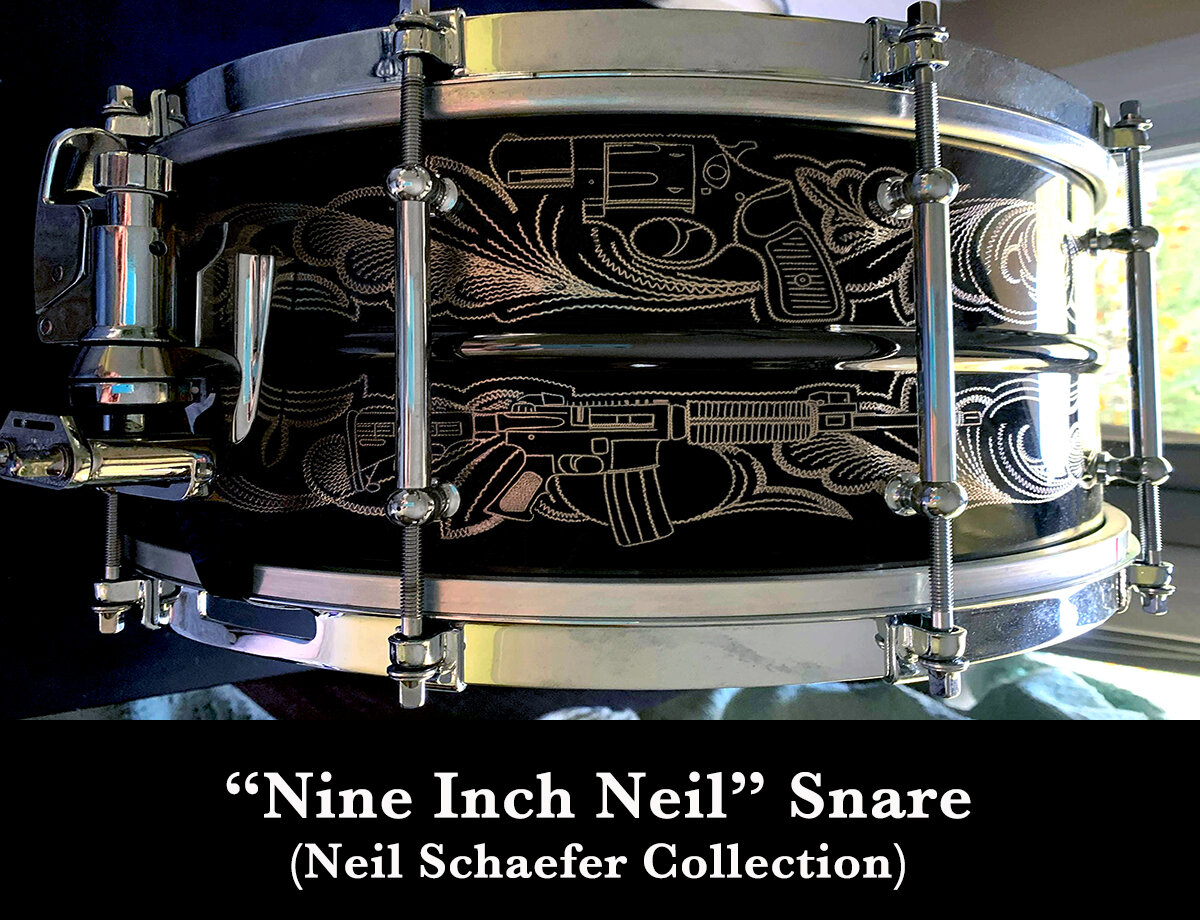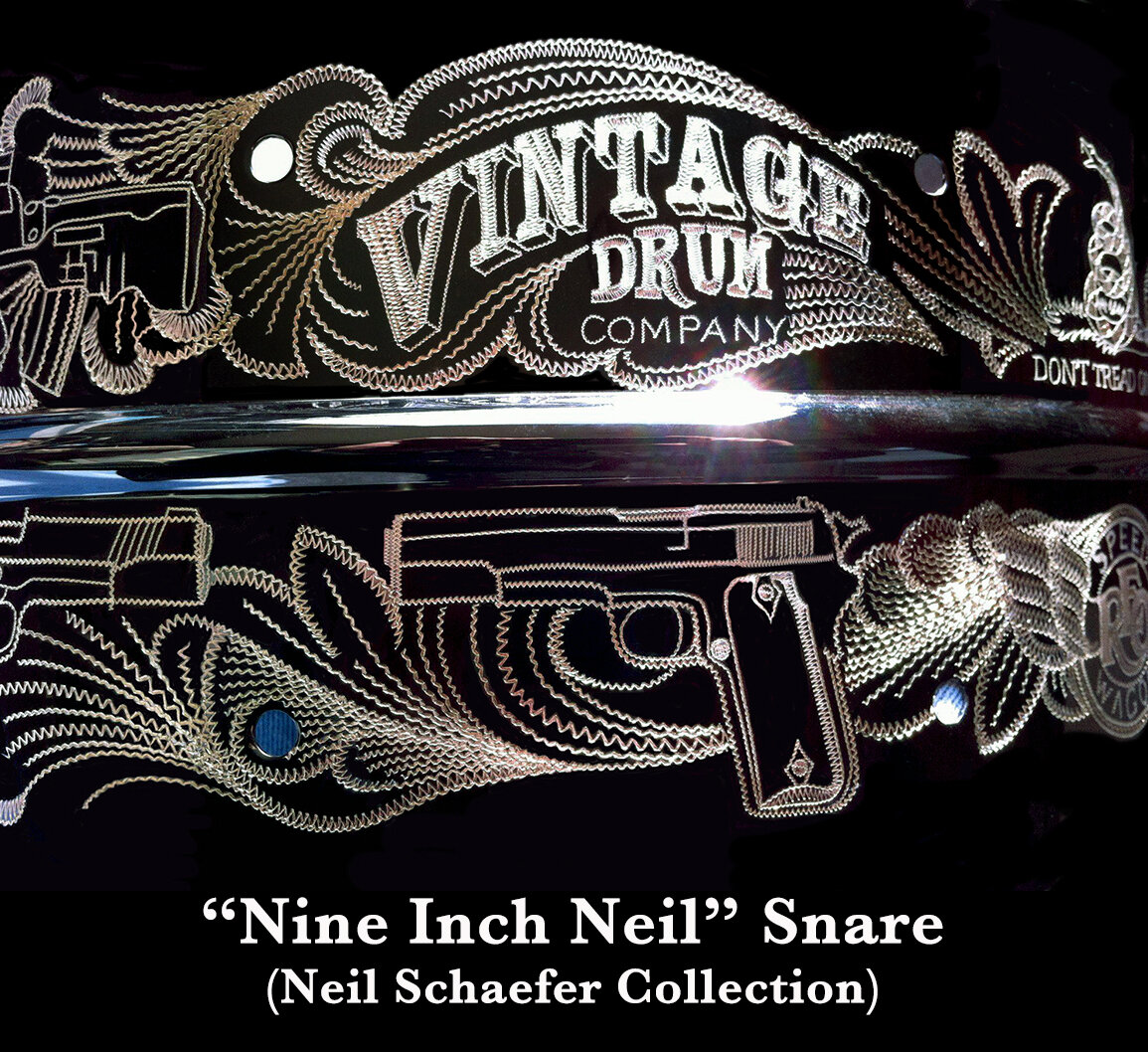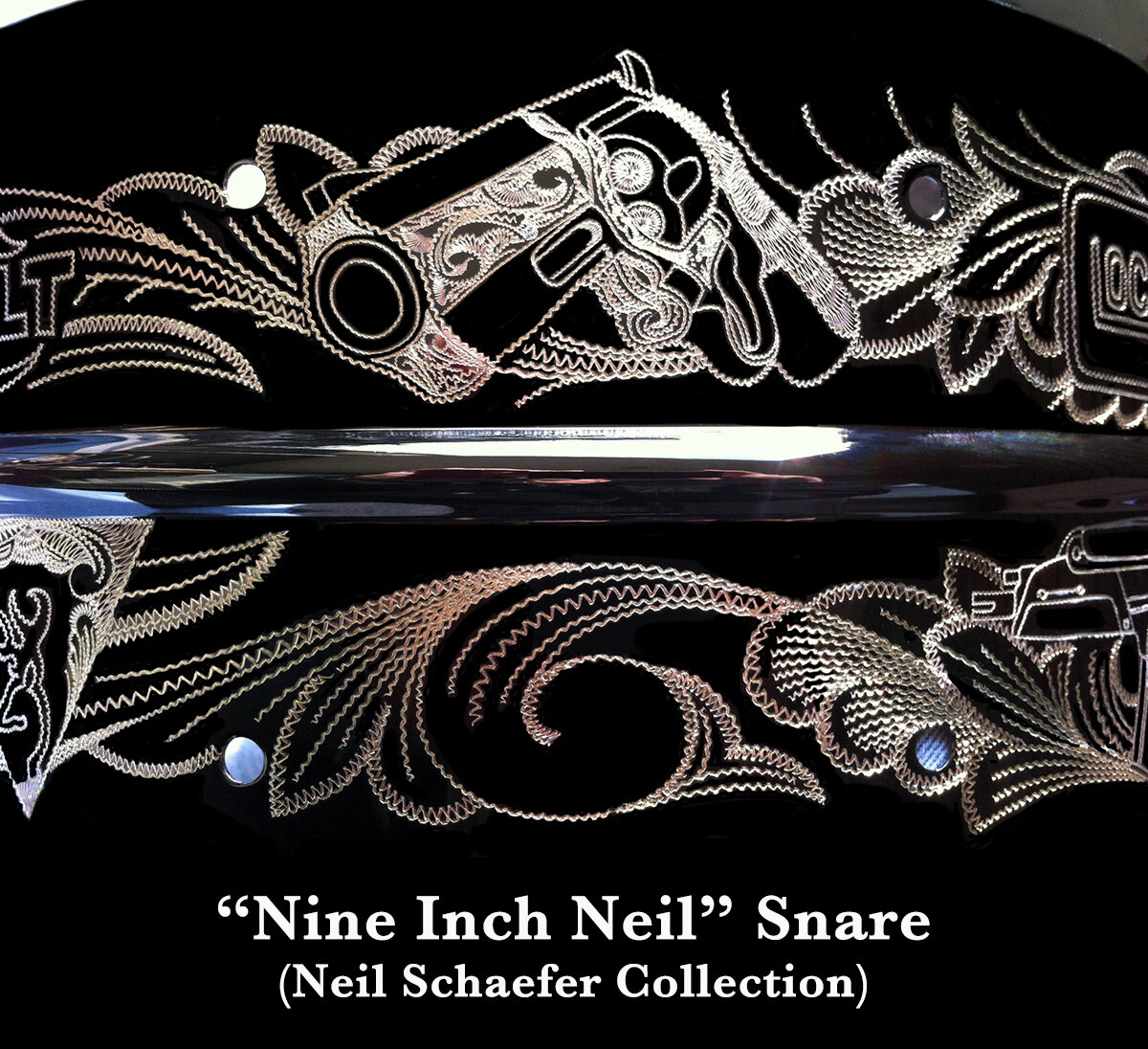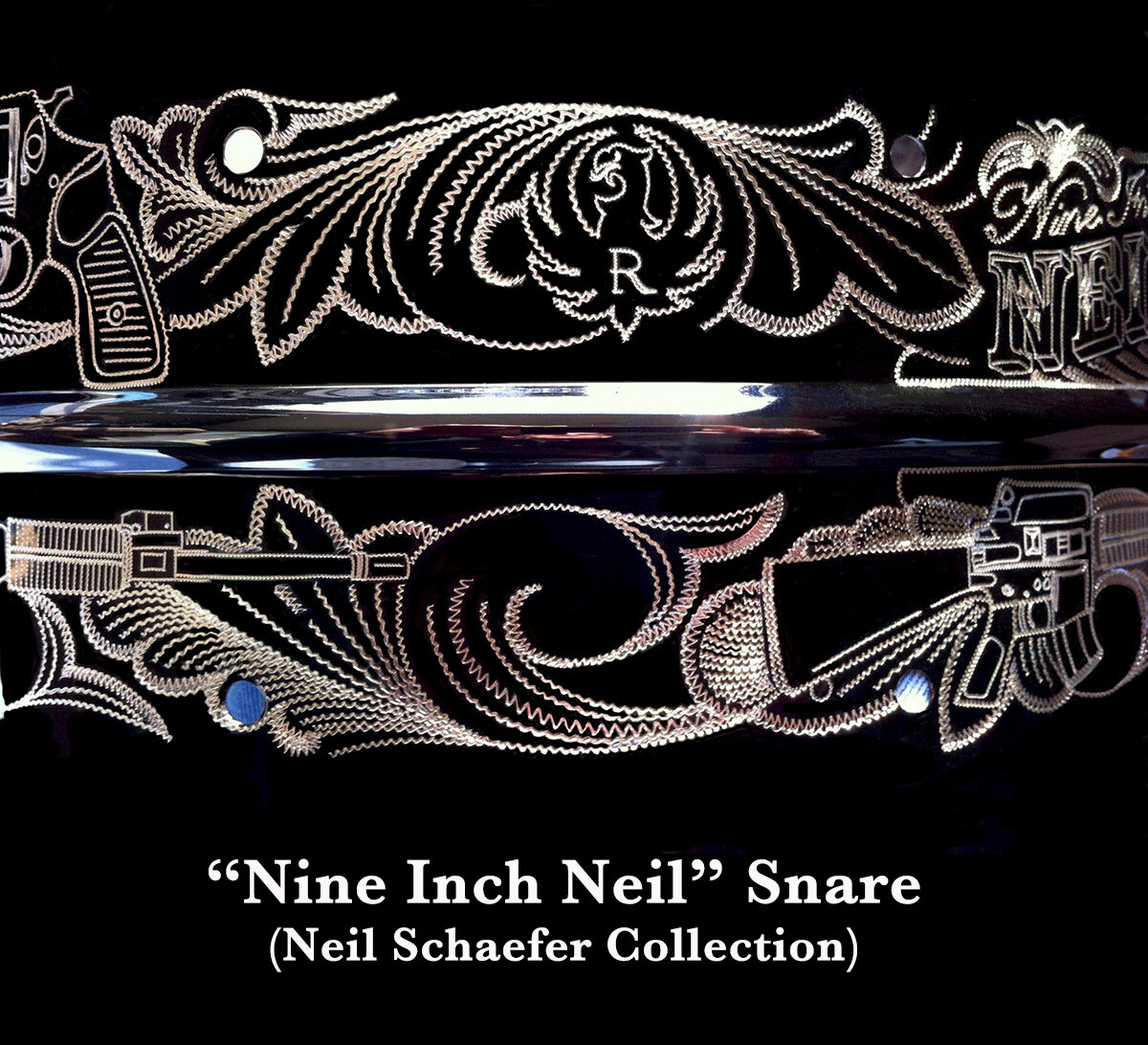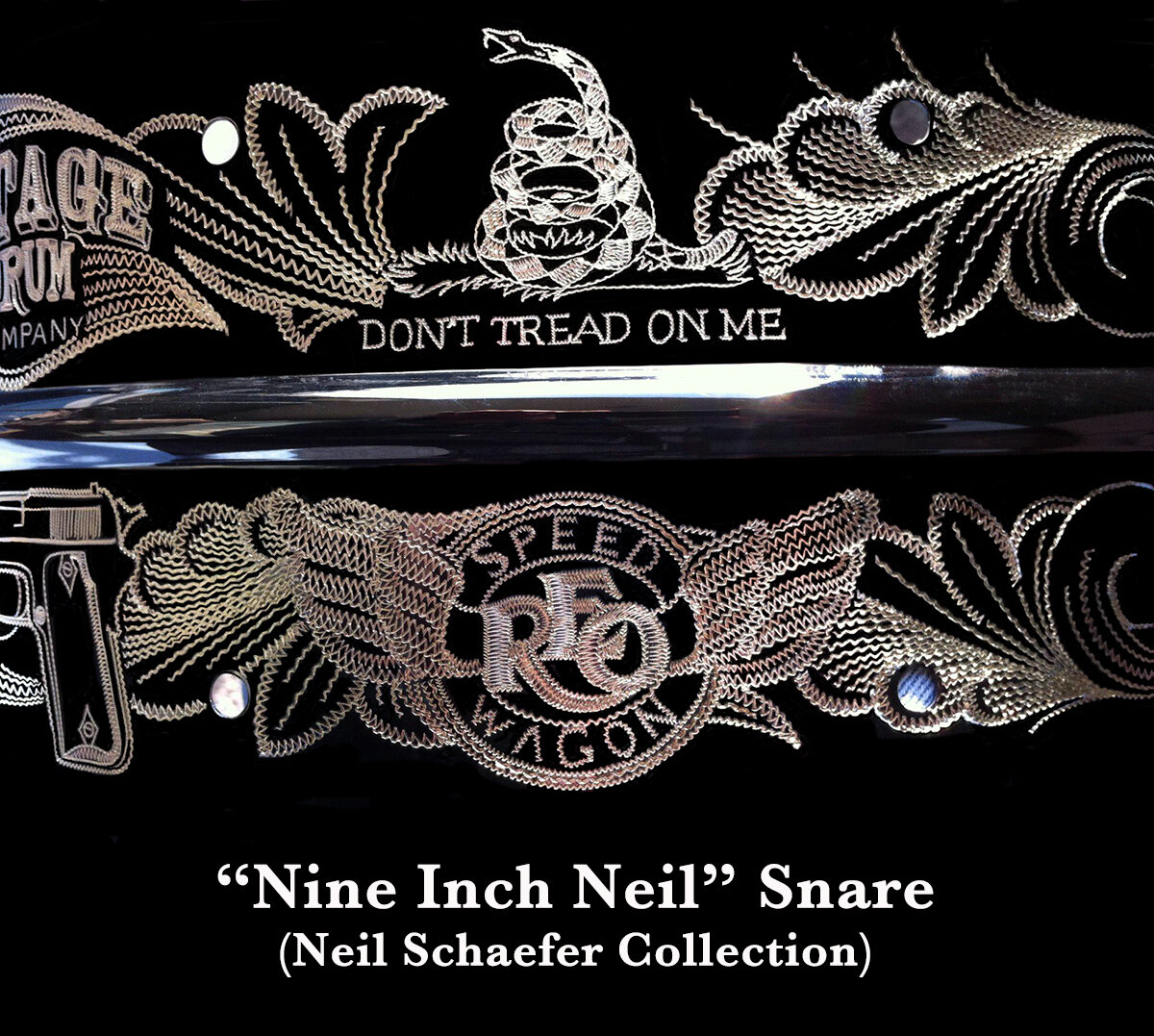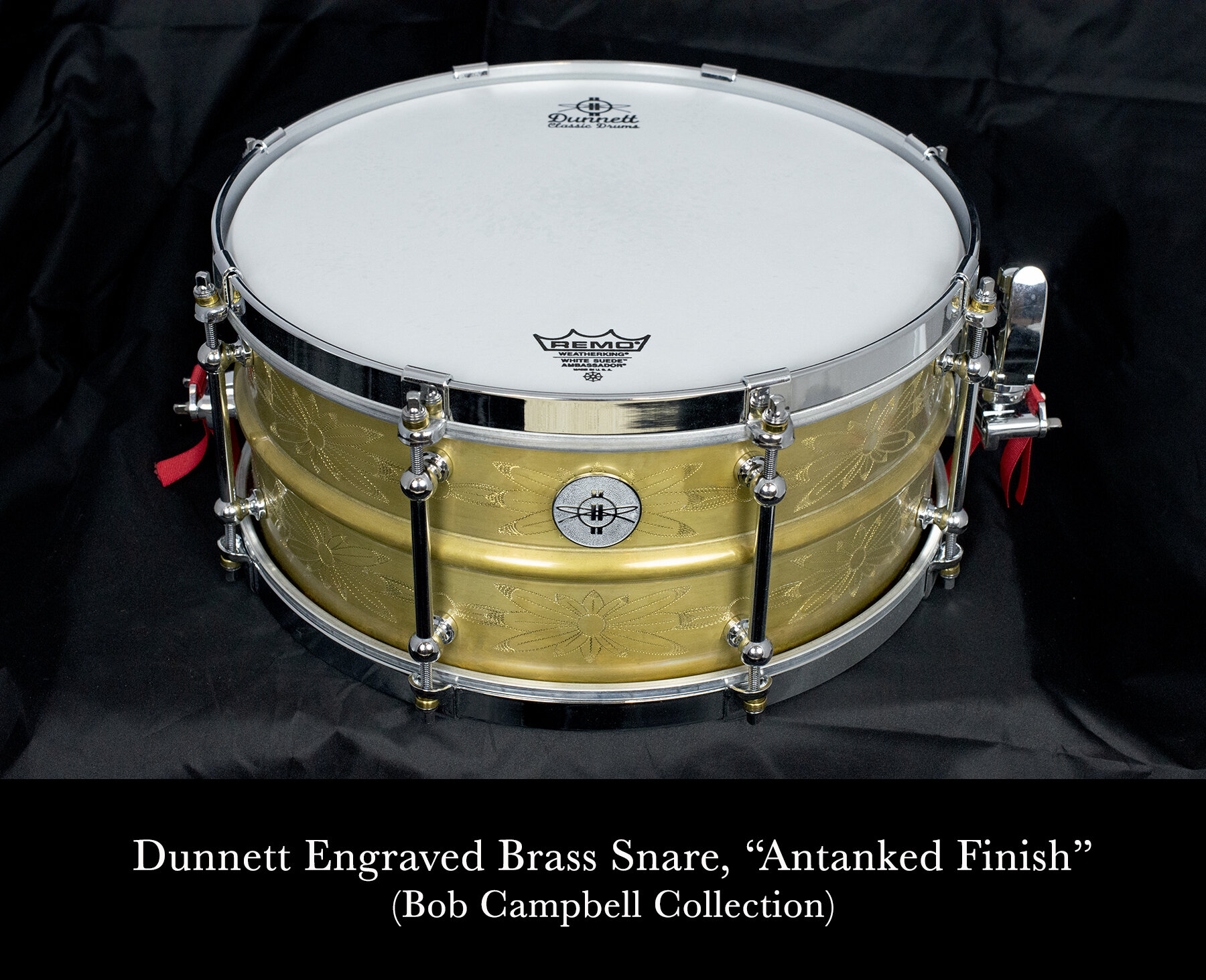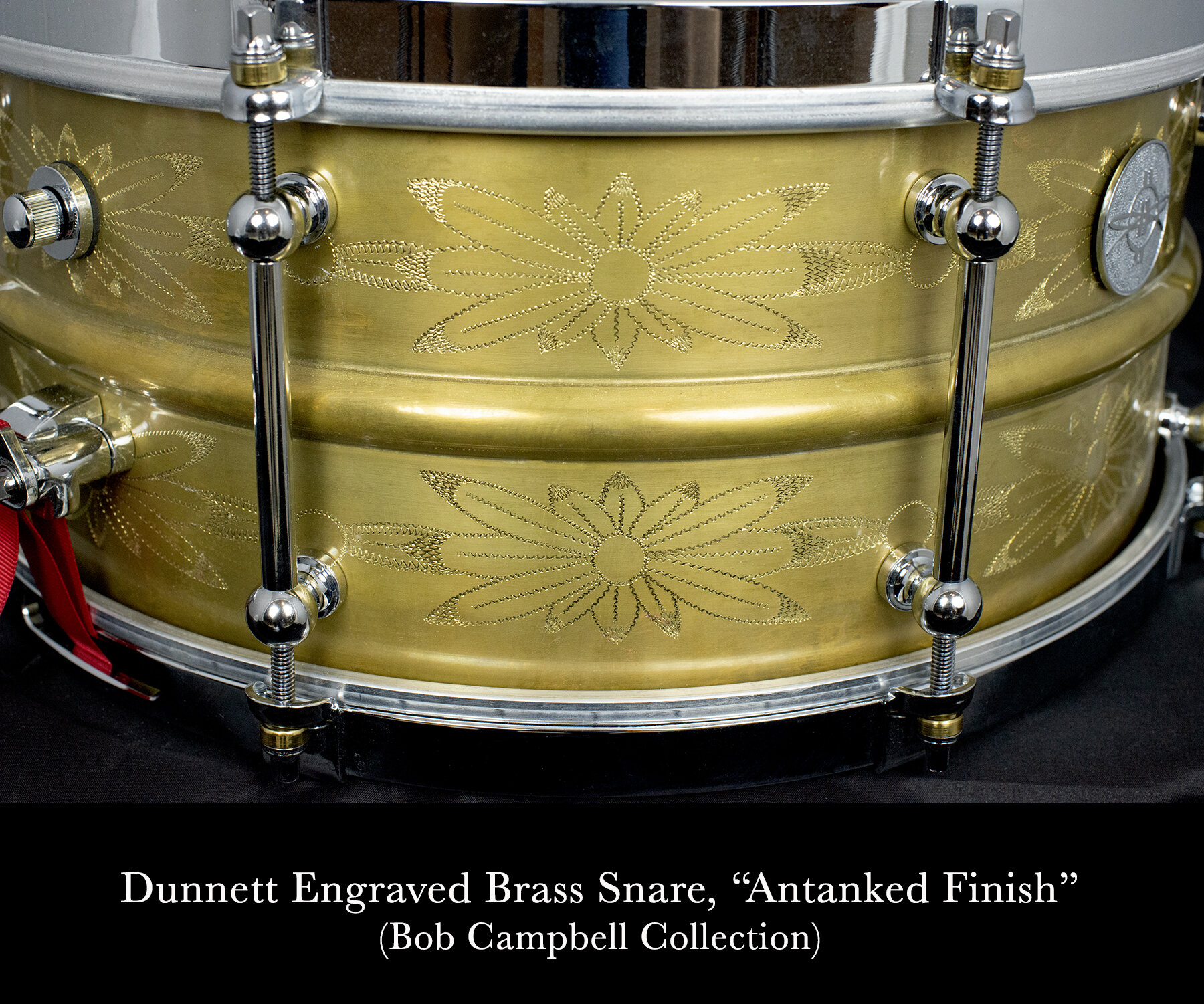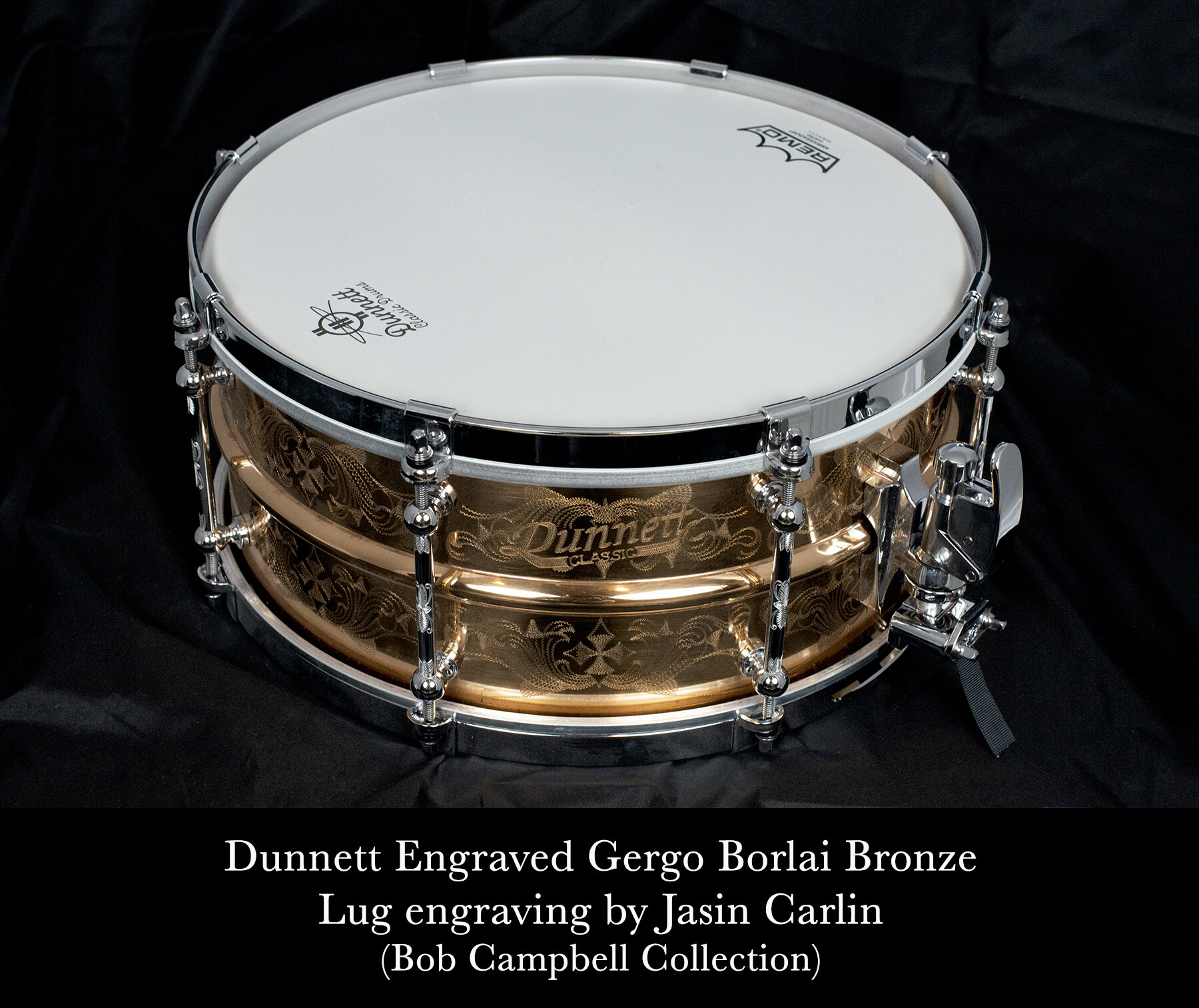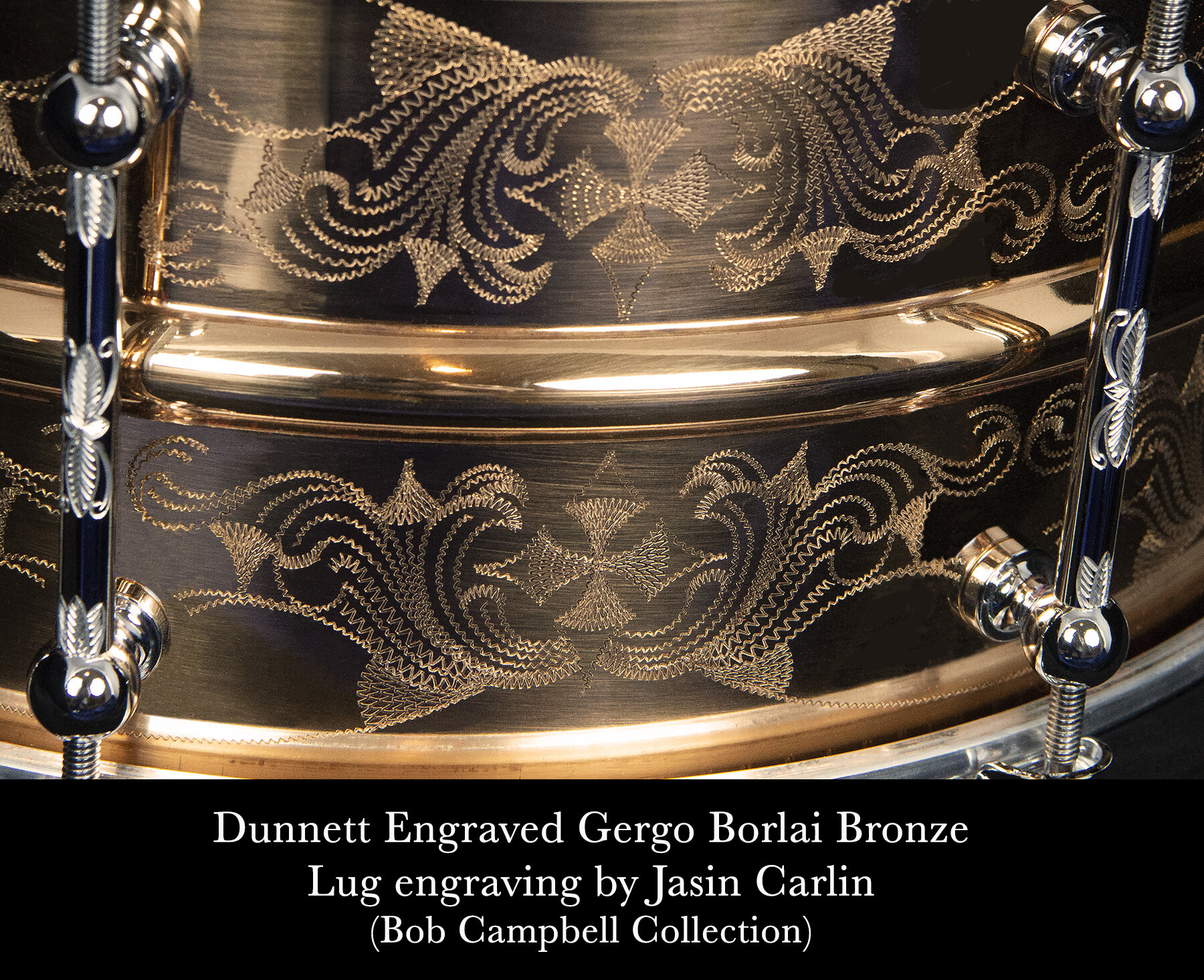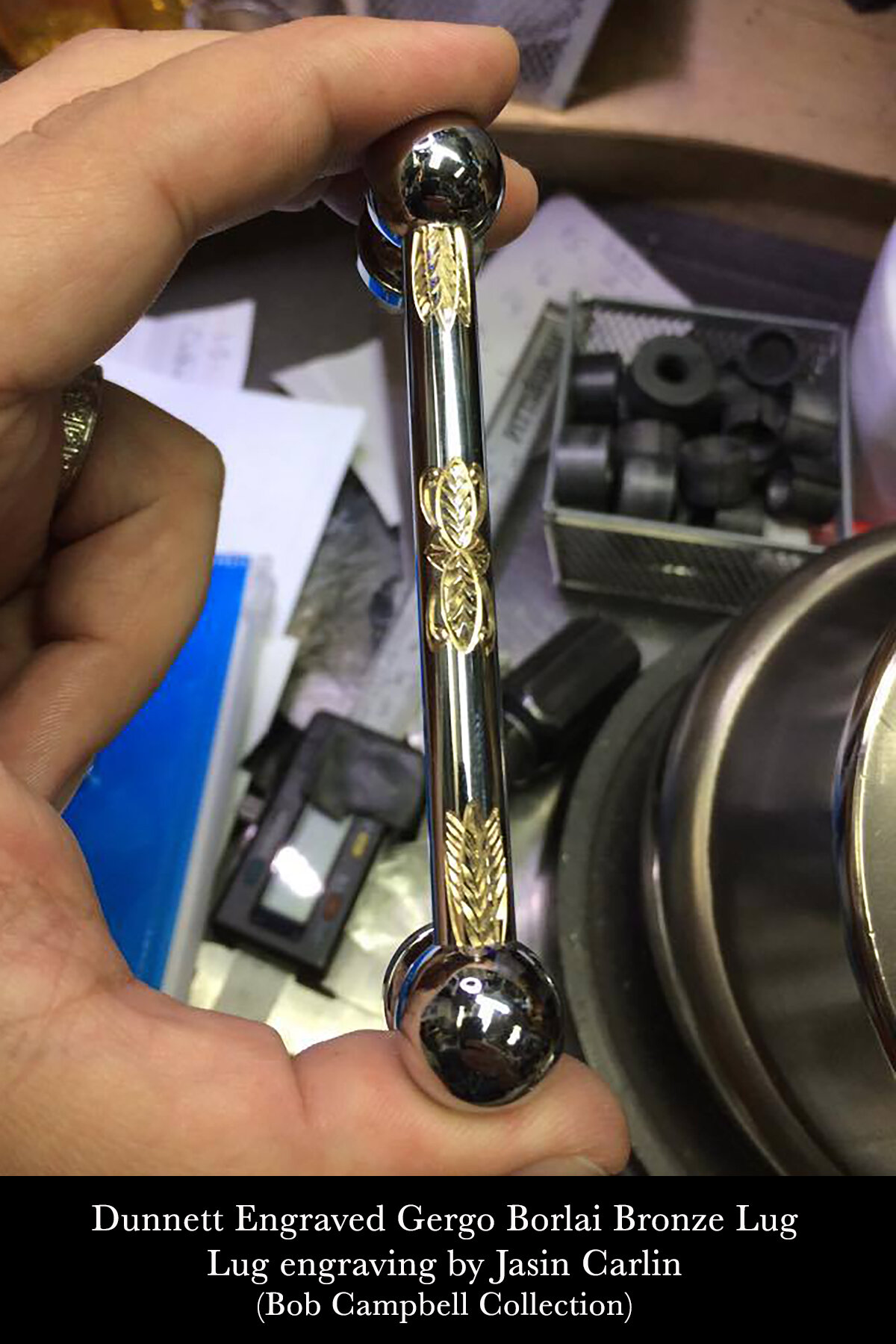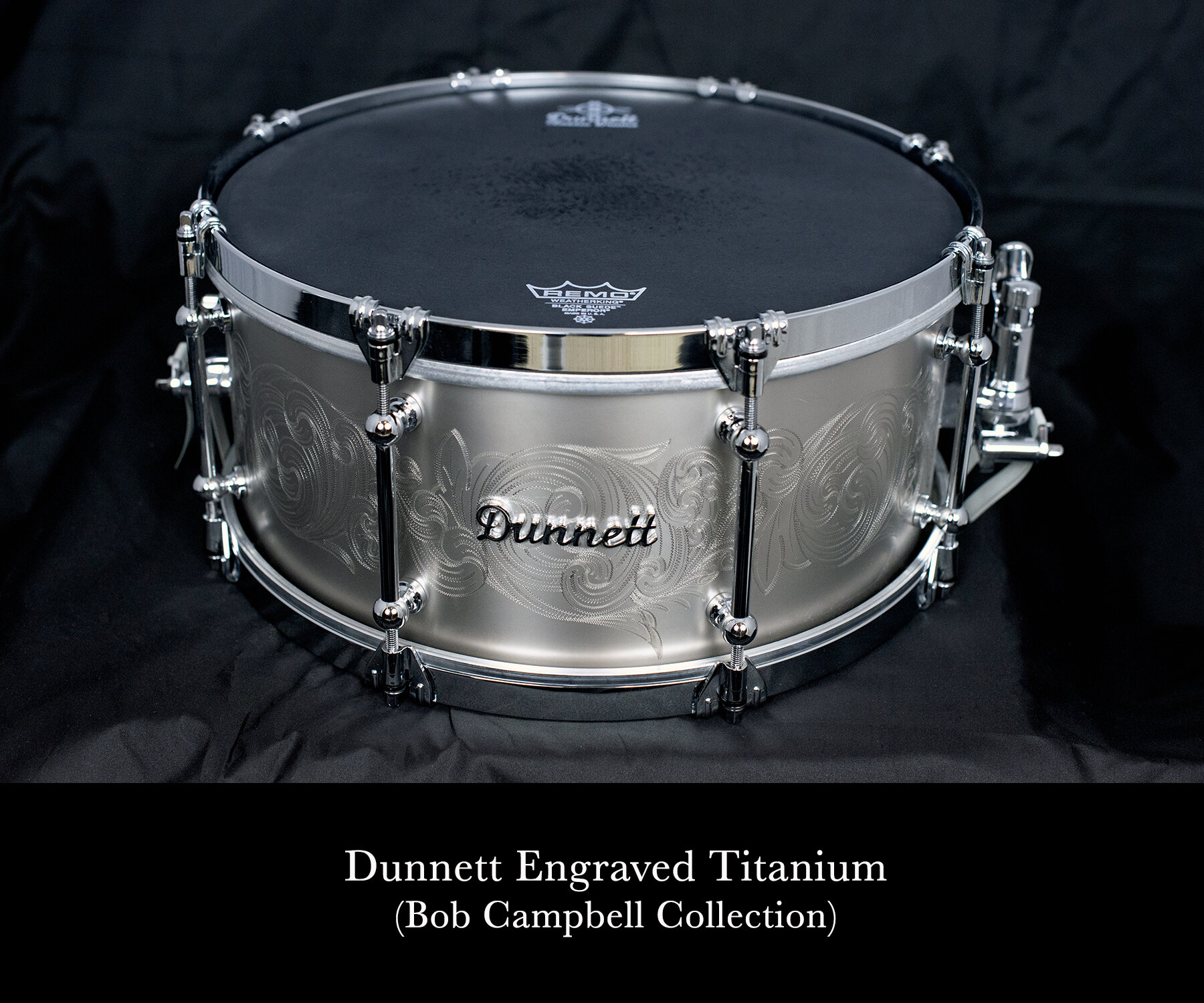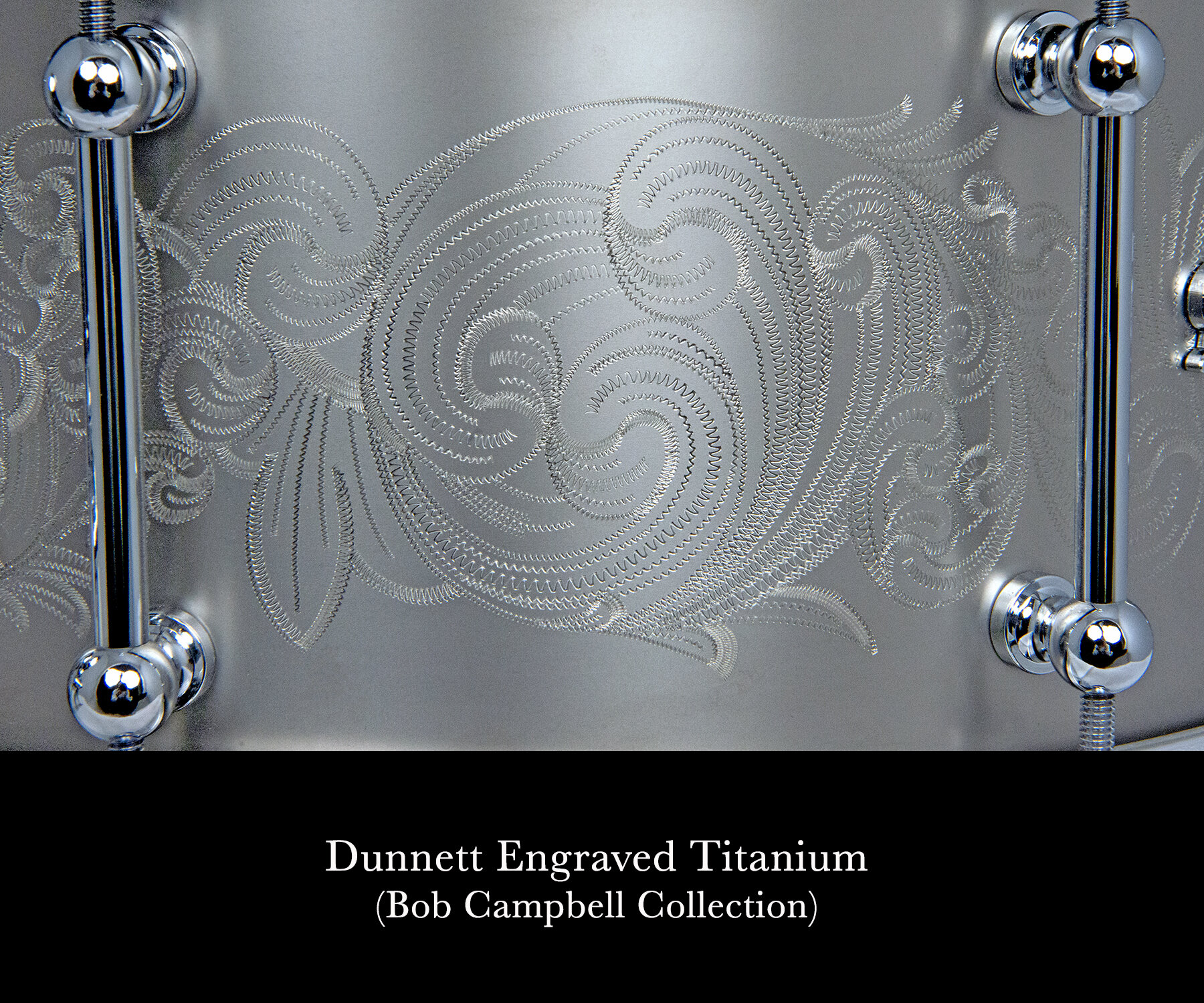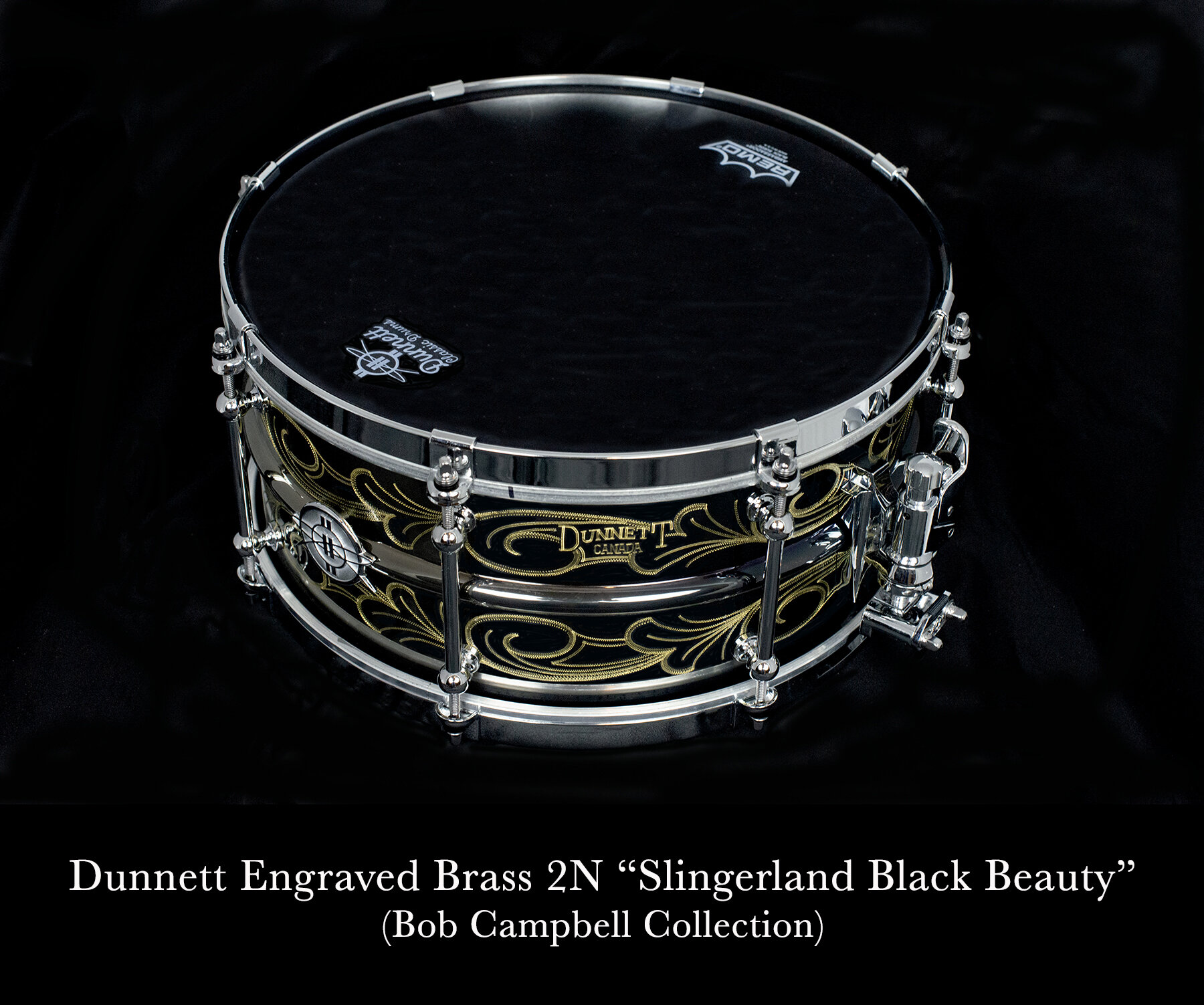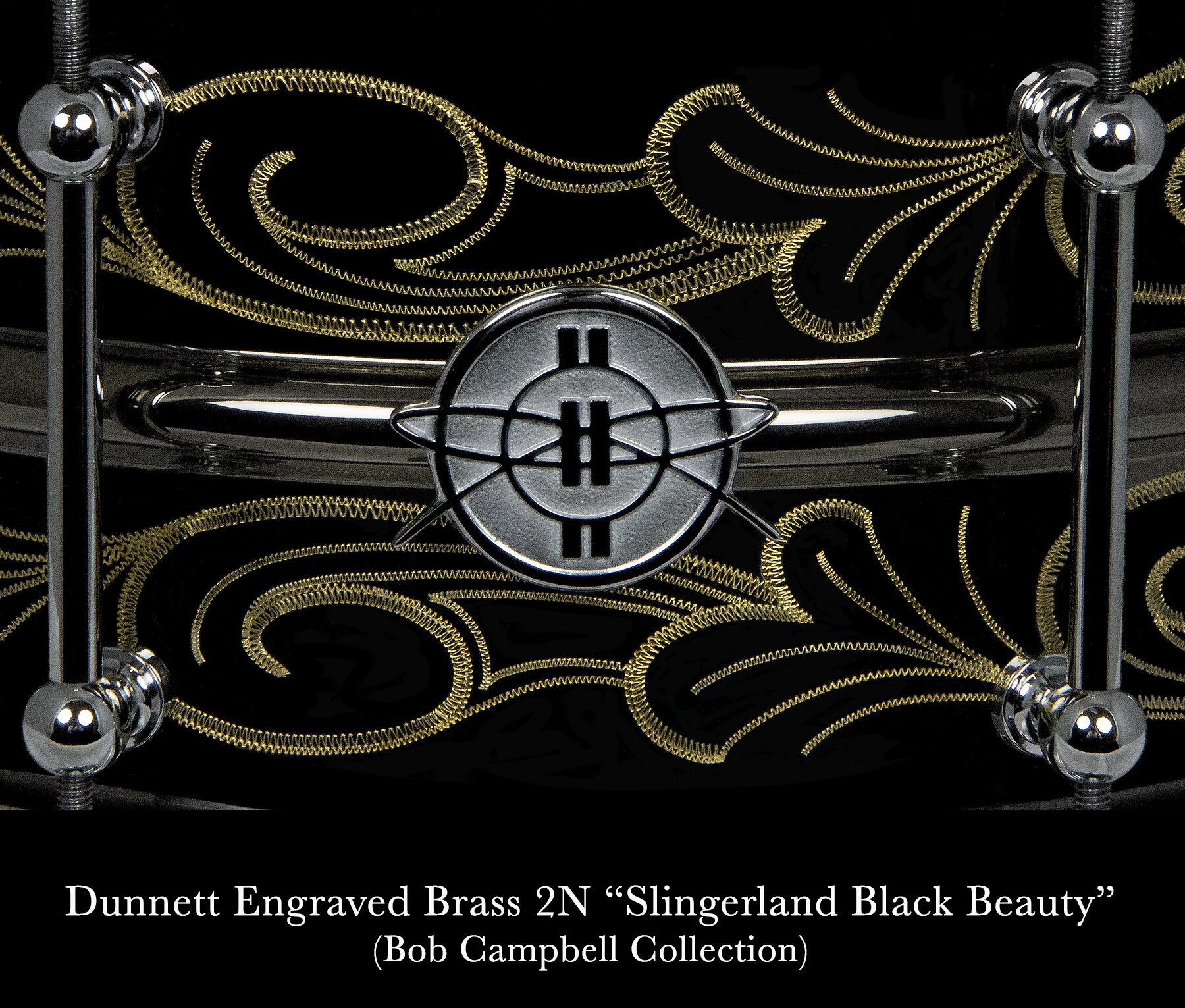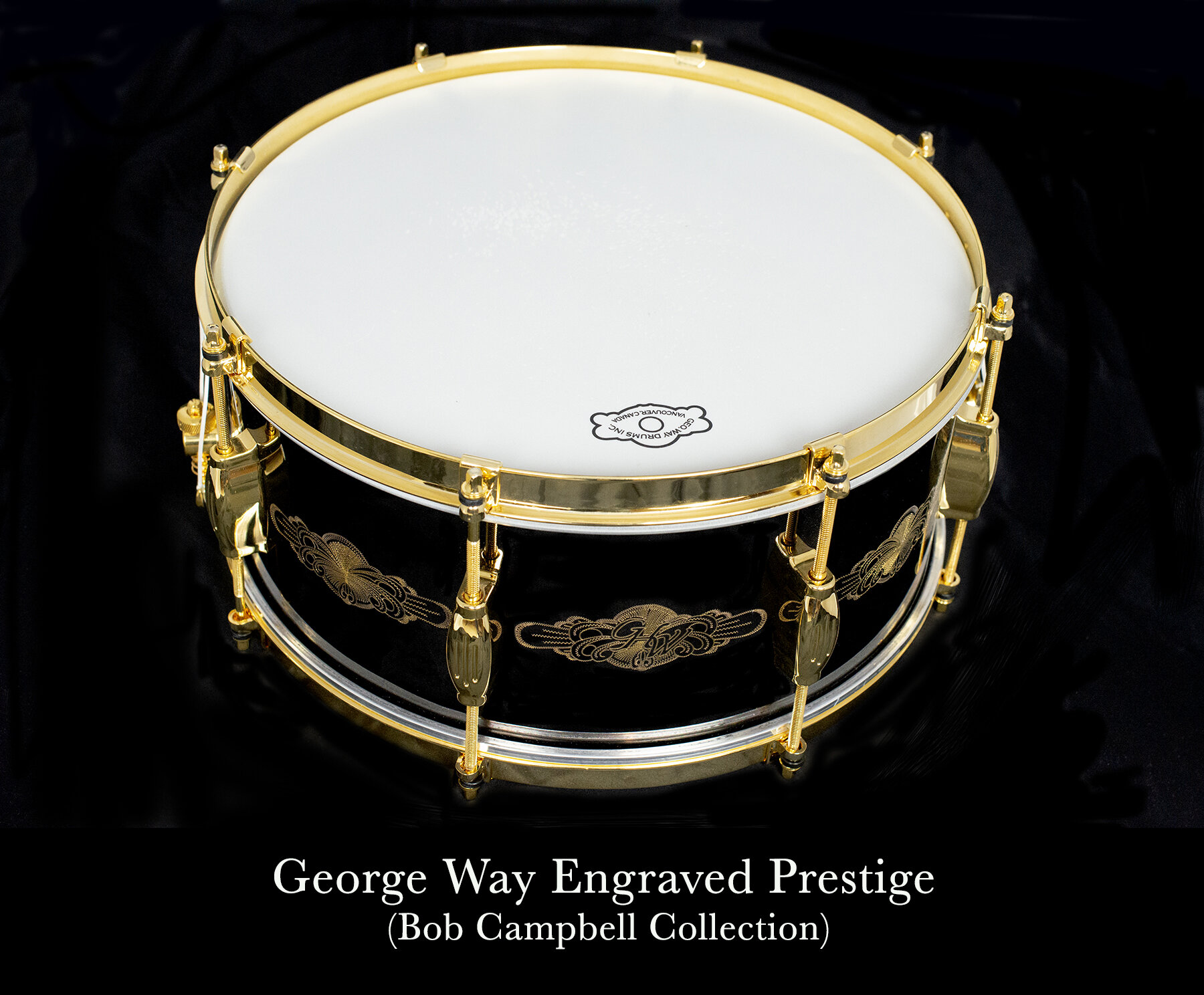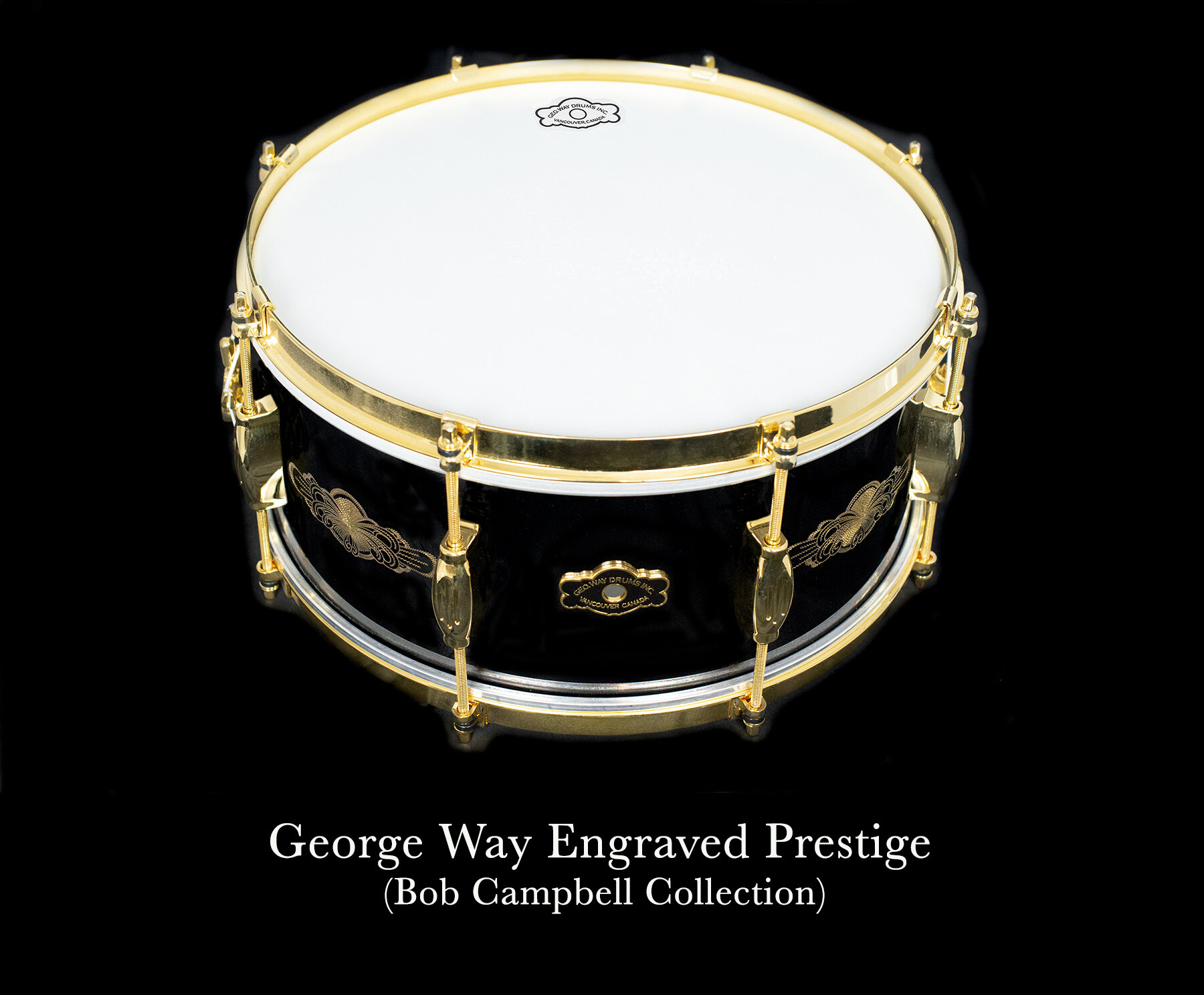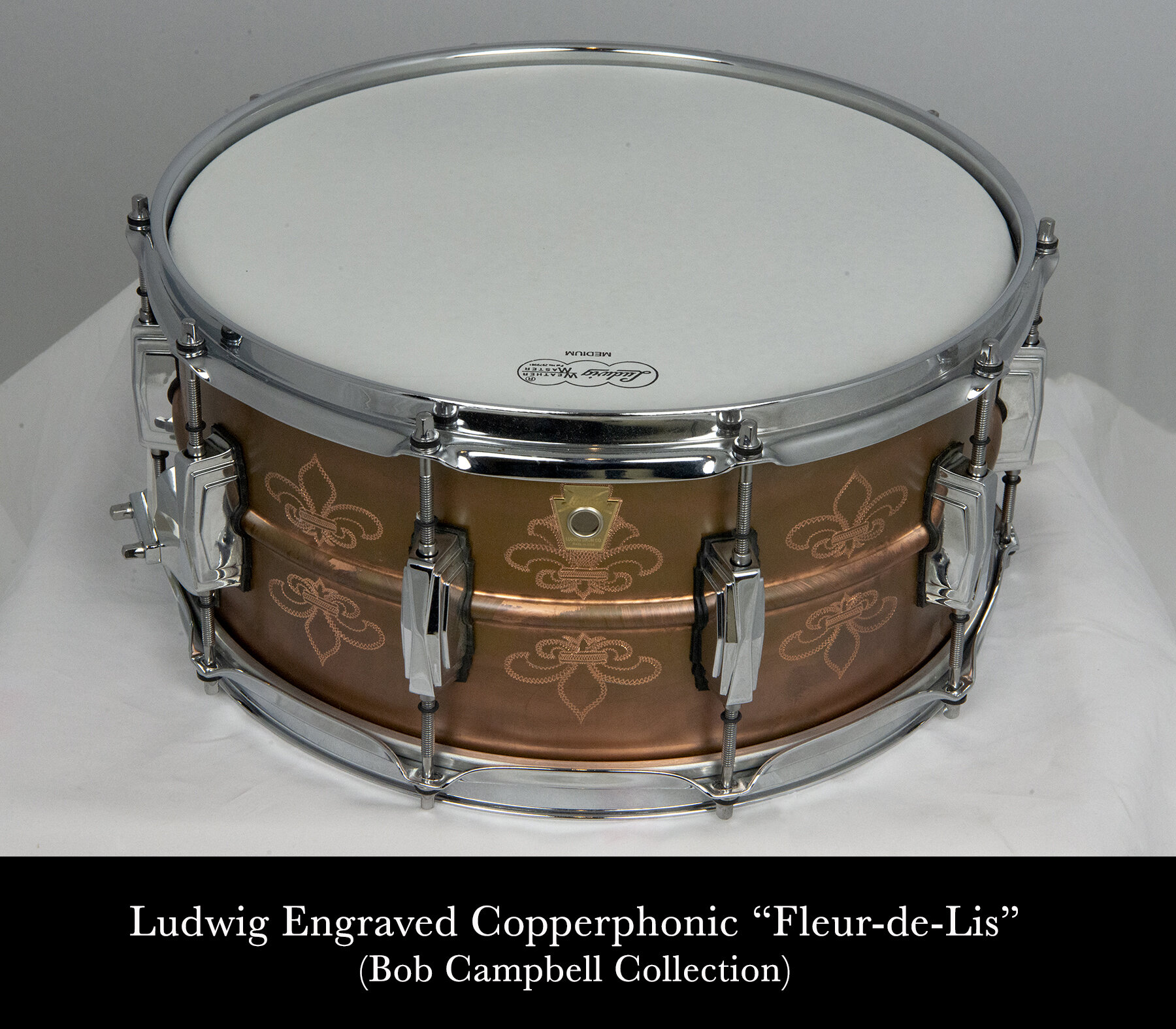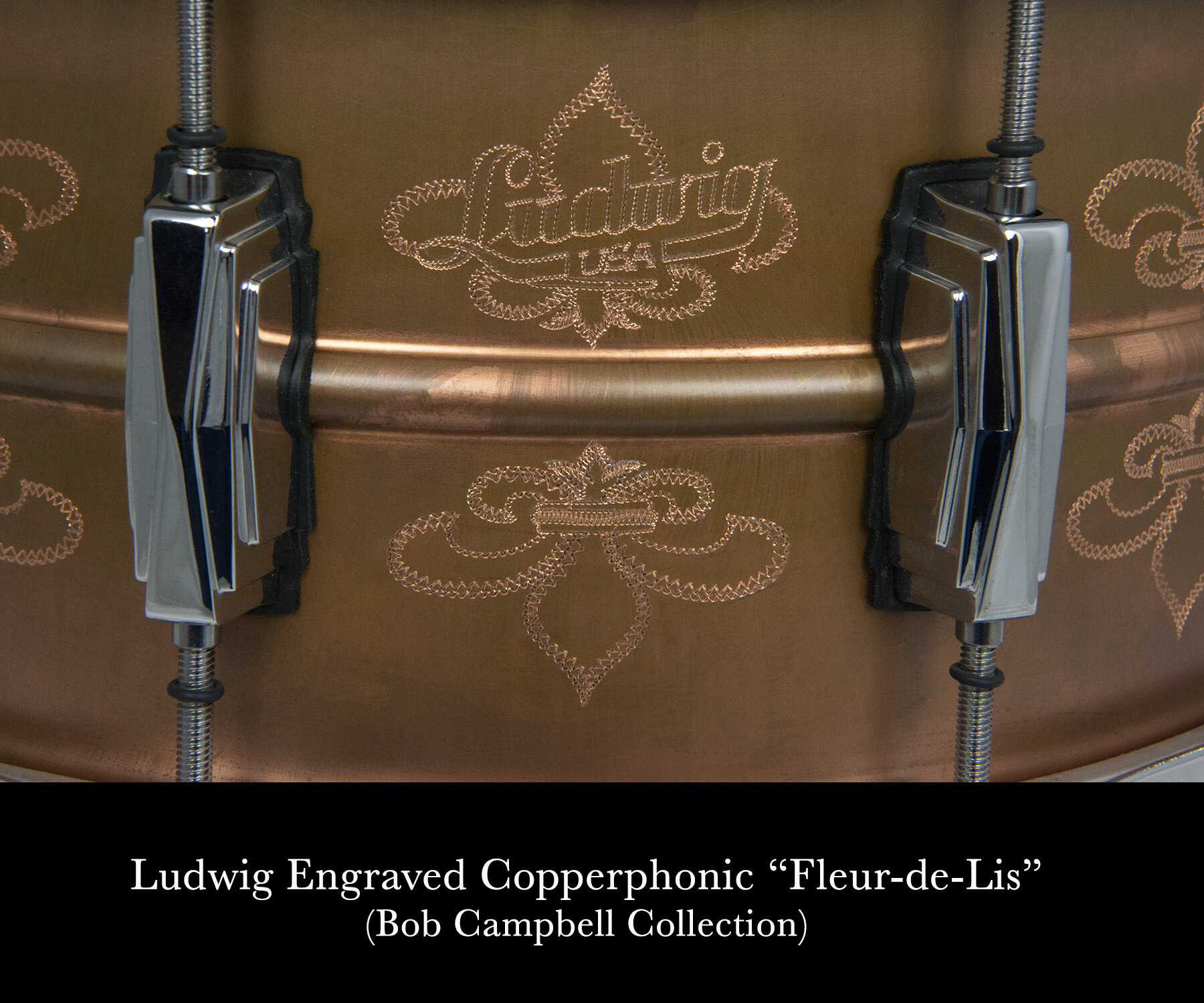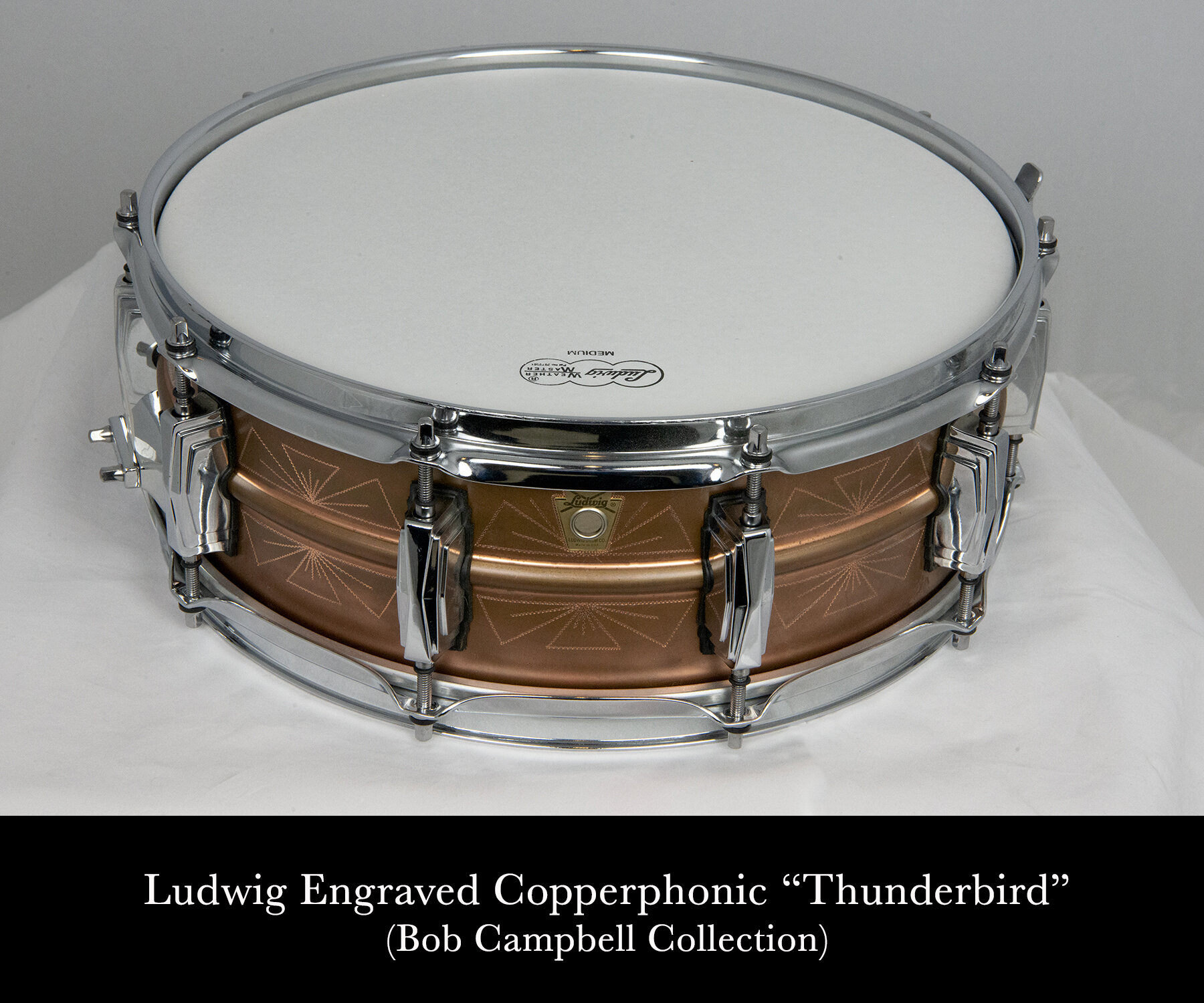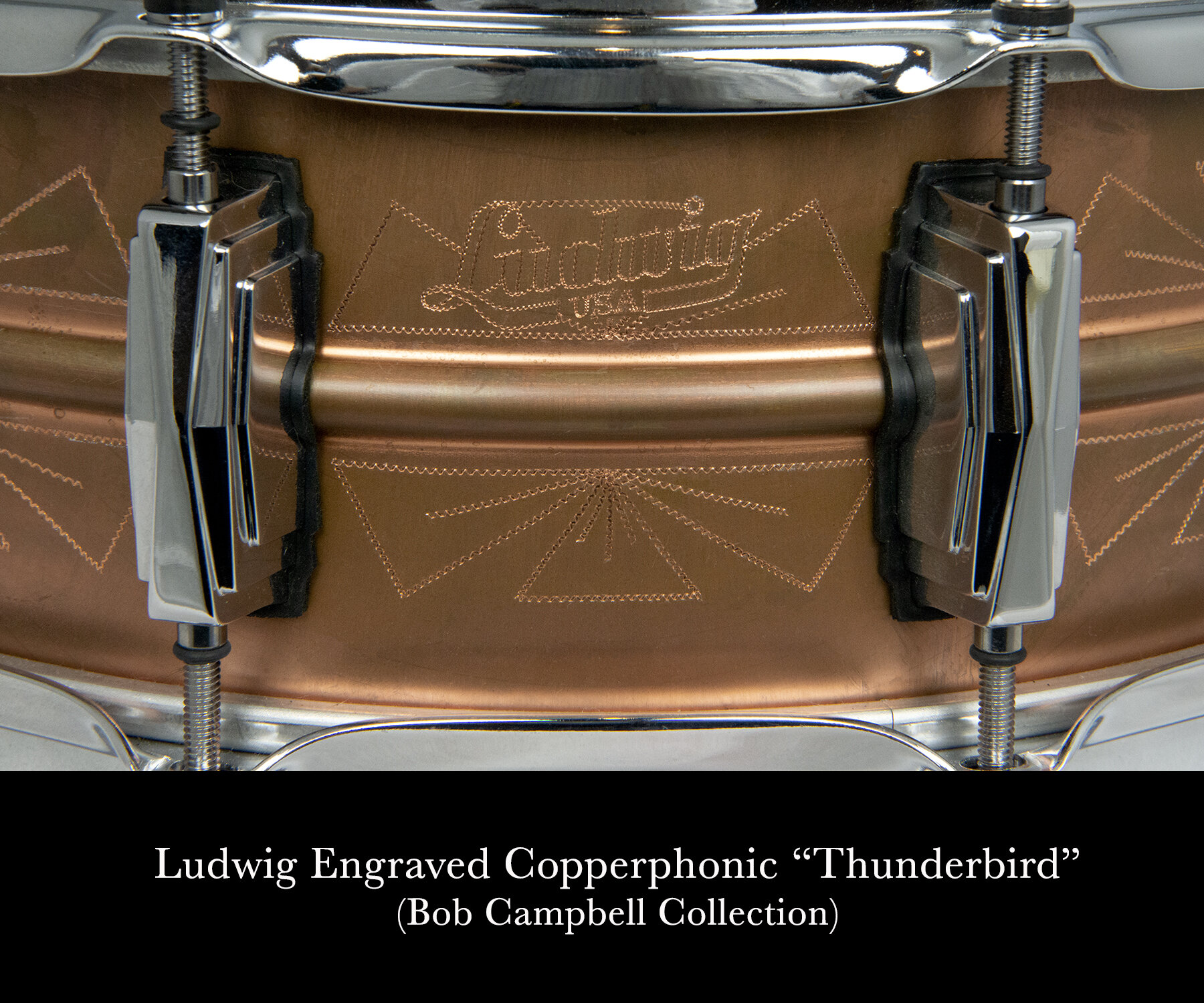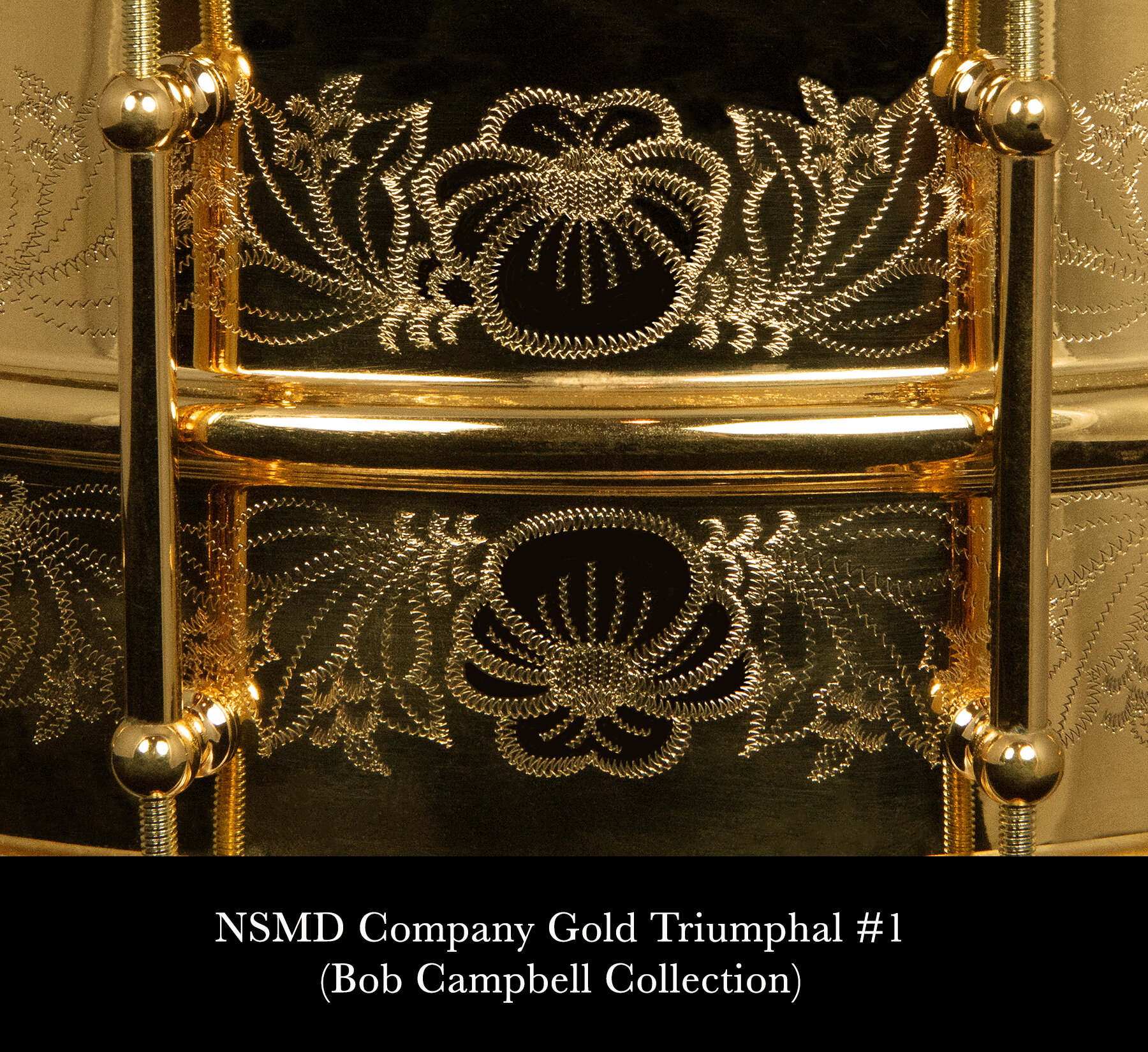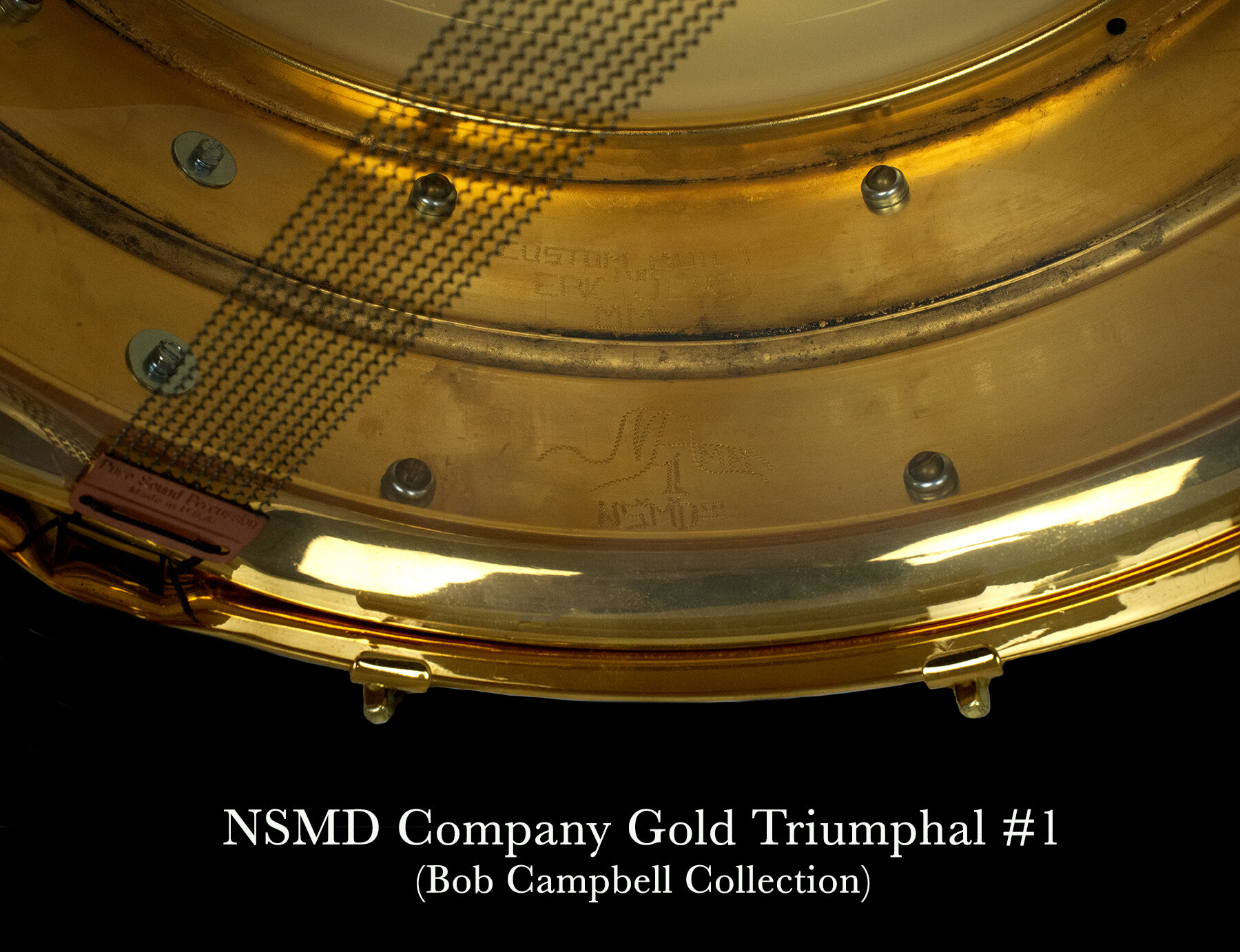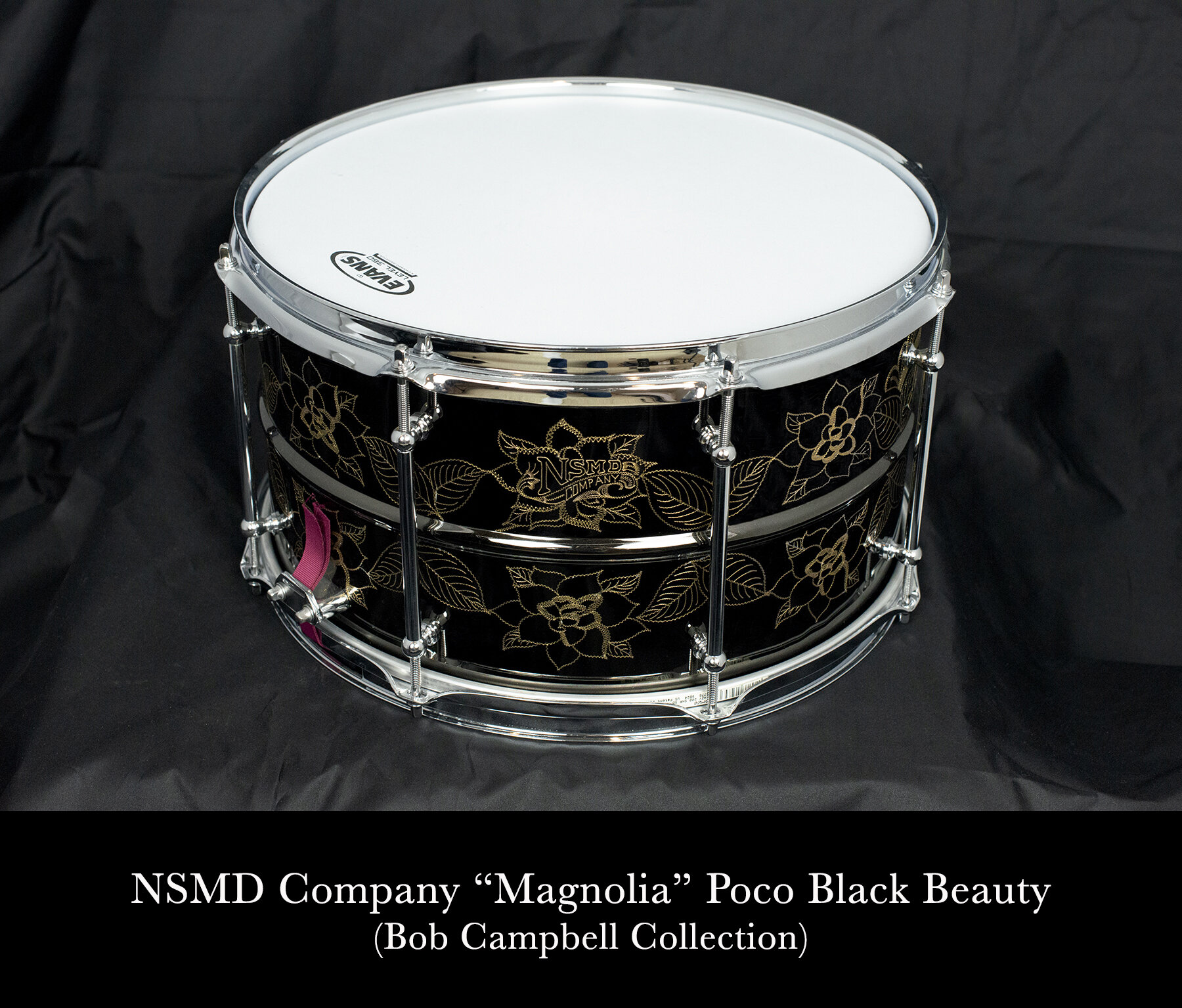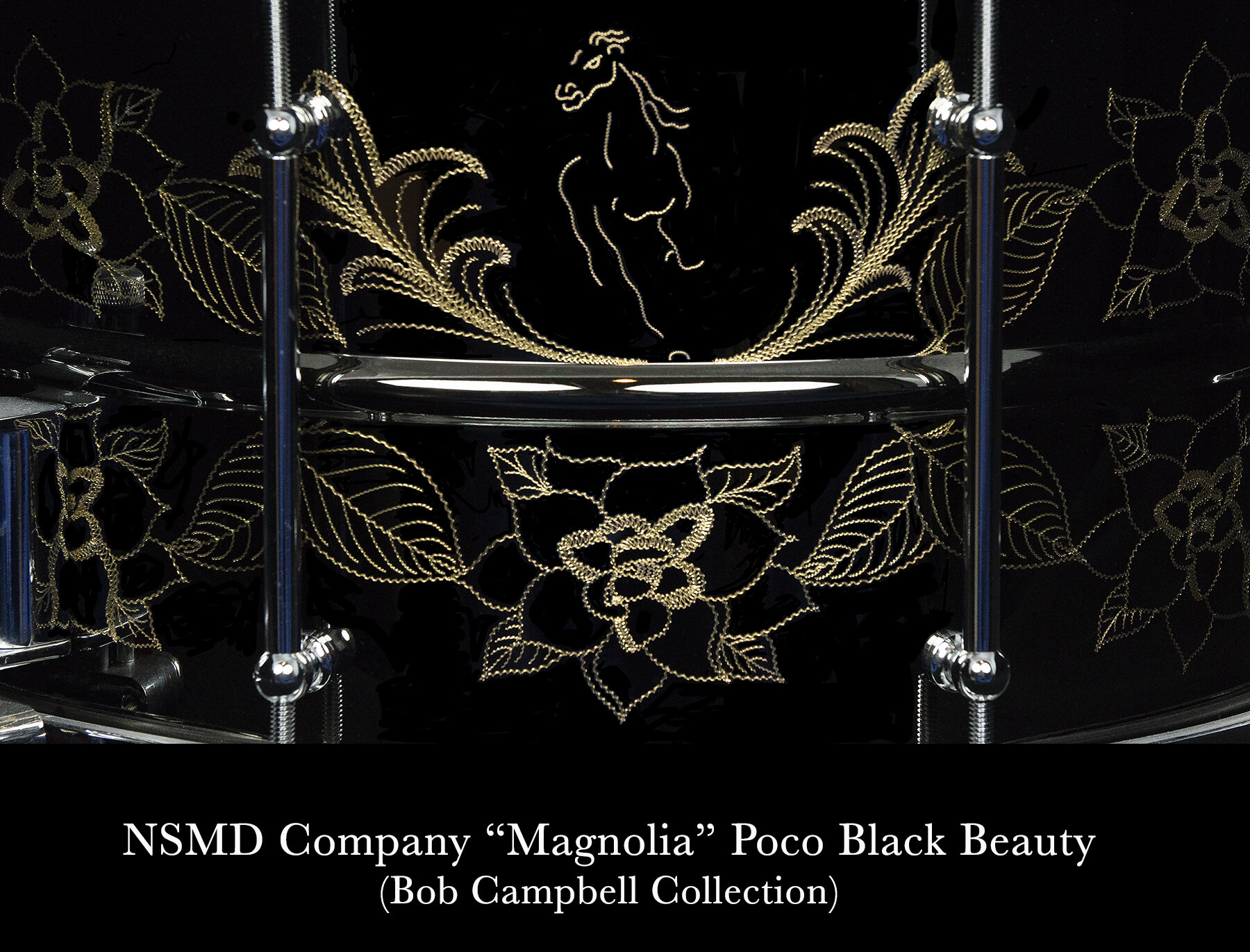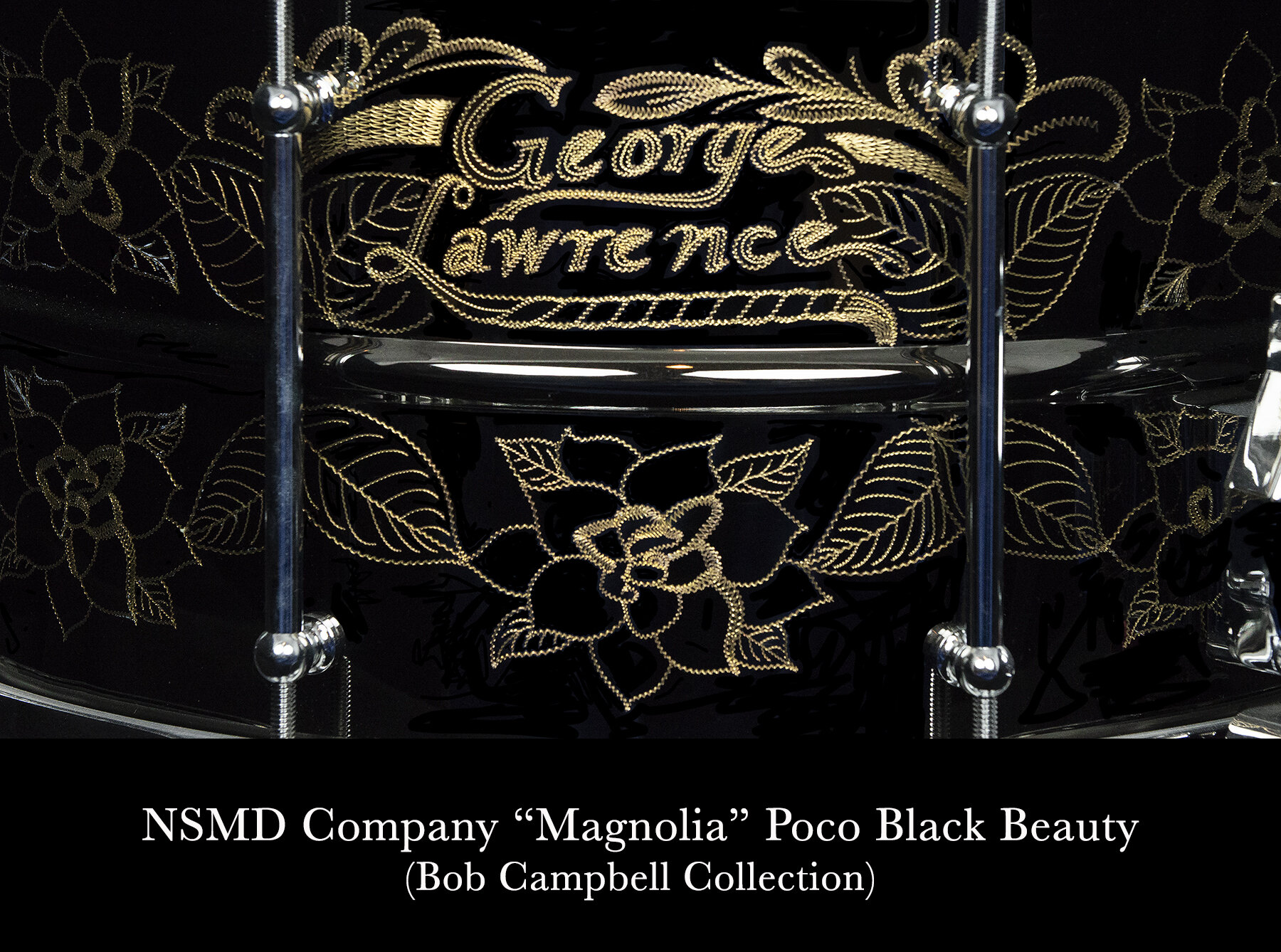In the first article of this series, I discussed the history of drum engraving with one of the most prolific and talented “drum scratchers” in the world today, John Aldridge:
I like to think of John Aldridge as a “Drum Jedi Master”. He is an endless wellspring of drum history, wisdom, experience and creativity. In this sequel to Part 1, I wanted to share some examples of John’s unique custom works with personal insights from John about their design. Many of these drums are from my personal collection and are greatly treasured. It is my hope that drummers will not only appreciate John’s incredible versatility, but also realize that “drum art” can be truly personal. Drum engraving is not restricted to scrolls and florets!
NSMD: I’m curious how the early Ludwig and Slingerland scroll and flower engraving patterns came about. What can you tell us about their origins?
“A lot of people think that Ludwig scroll and flower patterns were unique to Ludwig. Not so. Those were actually popular patterns of the time period that were just adapted by Ludwig’s engravers. Other companies and other engravers used variations of those patterns in completely different ways. Some are more similar. There are some Sonor drums from the early to mid-1920s that look identical to mid- to late-1920’s Ludwigs. The flower pattern that’s on the Ludwig drums, as far as I can tell, came out about the same time on the Sonor drum from Europe. The scroll pattern we think of as Ludwig could have been found on the wall of a house constructed by a stone mason. Scroll patterns were in use for hundreds of years.
We like to think that our guys were entirely original artists and came up with unique things, but everything was really just a product of its time. Back in the teens and twenties, that was the heyday of industrial art. People were just getting into the mass production thing. There were still people left in the industry who spent their whole lifetime perfecting things like engraving patterns – all kinds of patterns on silverware, guns, drums, and other things that were used in everyday life. Anyone who was alive during that time period would recognize those as being quite common. Over the course of time, we’ve lost touch with that. All we see now is what’s unique to our particular experience and have assumed that belongs to our industry. It took me a long time to figure out that we (drum engravers) are not an island at all. We were just the very lightest fringe of culture at that time. We took a lot of ideas from the turn of the century and applied them to musical instruments. Those same engraving ideas that were popular from around 1875-1915 are still being revived and reused today.”
NSMD: How do you approach a new engraving project when someone calls you for something unique and different than you’ve done for others?
“Most of the time when someone calls and asks for something special or personal, they have an idea that relates to other interests or hobbies. It could be gun gear, hunting related stuff, animals, dice or whatever. I’ll integrate them onto the drum and put a classic design behind it. A good example of this is a drum I engraved for Neil Schaefer, our front-of-the-house sound engineer. He is a rabid gun collector and drummer. He went to the point of even becoming a gunsmith. He wanted a drum with guns on it. I told him that I knew nothing about guns, so I asked him to send me some gun-related artwork. He sent line drawings of specific guns and logos of gun companies that were popular among gun collectors. There was one 3D drawing of a gun pointed at you. I put a gun or a logo of a gun company on every panel and then engraved a scroll design behind them to tie it all together. I thought it would be cool to add the 3D gun, so I made the gun look like it was pointed at you and engraved it as well. It was an engraved gun on an engraved drum. Neil was the REO front-of-the-house engineer for 30 years, so there was an REO logo. It was probably the coolest and most interesting drum that I’ve done in the last 10-15 years. It was one of the most fulfilling things I’ve done because it was for a true friend. That 6.5 X 14” brass drum (WorldMax shell) was engraved ‘Nine Inch Neil’.”
NSMD: How do you respond to a drummer who wants something like a vintage pattern but modified to be more “modern”?
“There’s lots of guys who wanted a pattern that looked old but didn’t want it to look like anyone else’s drum. Ronn Dunnett is a classic example of that. He’d likes vintage patterns that look Ludwig-esque or Slingerland-esque, but he doesn’t want to copy them.
For most people, the first thing I’ll ask is what they want personalized on their drum. It could be their name, or a date, or as I said before, an interest or hobby. I had a real interesting customer some years ago who wanted to memorialize his grandmother on his drum. She had been a vaudeville entertainer and had a tremendous impact on his life. She also liked to drink. I integrated everything into a pattern with the over-arching theme focused on Mae West. I put silhouettes of Mae West on the drum along with highball glasses of various sizes hidden throughout the pattern. For the background, I used a classic gun scroll pattern. That was the start of my doing things truly individualized.
The next guy who came along wanted barber stuff – barber poles, razors, scissors, and things related to barber history. I put a barber pole behind every lug of that drum. I engraved a set of straight razors and buzz cutters. In one panel, the buzz cutters are shredding a set of straight razors. In another panel, the straight razor is cutting the electrical cord of the buzz cutter.
I try to make these drums as unique as possible and put some artwork behind it. You have to look closely to figure out it’s not just a scrollwork drum, but there are details about what this person was really into. Everybody has part of their life they want immortalized on a drum, and they want their kids to keep that drum to share what they did with their life.”
NSMD: Can you share some of your thoughts on designing and engraving the following beautiful examples of your custom work?
1. George Way engraved black nickel over brass Prestige snare (circa 2010):
6.5 X 14”, double-flange hoops/clips, 8-Tuxedo lugs, gold-plated hardware
“That was the first George Way drum I ever did for Ronn Dunnett. The thought was to take a George Way idea and combine it with a Camco idea in a way that nobody’s ever seen before. Ronn had just purchased the intellectual rights of George Way’s estate and wanted to showcase stuff that George had done in his life that hadn’t been seen before.”
NSMD: The engraving pattern on this drum is particularly unique. How did that design come about?
“The engraving pattern on this George Way Prestige snare – that’s based on the outline of a Camco/George Way badge. I took each one of the curves as the outer curve of a scroll with an additional wing on either side. I tried to symmetrically draw curls or scrolls that ended up in the center of the badge that would make a nice symmetrical scroll pattern within the Camco/Way badge shape. I wanted to make the center pattern solid, so I made a lot of radiating engraved lines. If you look back from afar, you just see the badge shape. When you step up close to it, you can see the scrolls that produced that. Outside of the badge shape, there are three little curves outside of that with some details on them. Those were based on a George Way drawing from his Little Black Book. He had drawn a lug design before he died that never got produced. Your’s is the only drum I ever did like that. I never repeated that pattern again.”
2. Dunnett engraved black nickel over brass 2N snare, “Dark Star” (circa 2017):
6.5 X 14”, single flange hoops/clips, 8-tube lugs, chrome-plated hardware
“This is a drum that you requested based on the 1928 Slingerland Black Beauty engraving pattern. The metal content of Ronn’s drum was such that I couldn’t make the broad strokes that people did when they were engraving the Slingerland drums in 1928. If you look at the original Slingerland Black Beauty, the zig-zag strokes within the curves are much further apart than I did. The softer the metal and the thinner the black nickel coating, the easier you can float that graver blade through the metal to make a really long stroke. On your drum, I used really close strokes making very tight zig-zags. On that particular metal, I couldn’t get the blade to float at all. You do what you can with the metal that you have. It’s a pretty pattern but using a different stroke.
This was an 8-lug drum where the Slingerland Black Beauty originals were 10-lug. To make it line up with the hardware, the patterns had to be stretched 1.125 inches in length. It's a little different proportion. I kept it all in proportion so it really fills up the gaps above and below (see sketches).”
NSMD: The ‘DUNNETT CANADA’ logo is engraved on the shell and has a distinctive design. Was this to make it reminiscent of the 1928 Slingerland Black Beauty?
“Yes, I wanted to make it the way Slingerland did it – with the first and last letters in large capitals. The goal was to make the Dunnett logo as similar as possible to the Slingerland logo of that period. I have to give Ronn credit for that idea; he’s very creative. He came up with the concept. Anytime I’m working on somebody’s drum, I’ll talk to the person that made it. I want to be sure the logo and design is the way they want it to look. I’d want somebody to do the same thing if they were working on one of my drums.”
3. Dunnett engraved bare brass snare, “Antanked finish” (circa 2014), “Curry”
6.5 X 14”, single flange hoops/clips, 8-tube lugs, hyper-vent, chrome-plated hardware
“That was another Ronn Dunnett idea (12-point floral with circular center). Ronn is very active in determining what you engrave on his drums. He wanted a drum with a classic floral design. I basically copied an early Sonor pattern I had. The circles in the center and linking petals between were added to make it a continuous pattern as opposed to an isolated flower in between each lug. With tube lugs, you can see so much more stuff. When Ludwig switched from using 8 lugs on its 14" models, the scroll patterns became a bit more cramped. This would obvious if you bought a 10 lug 15" black beauty from that time period with scroll engraving. Probably the reason for the switch from scrolls to flowers was more about establishing the 10-lug model as a NEW option and making it visually different to hammer the point home. Once you had the solid lug designs, they wanted a solid pattern they could see in between each lug and not be covered up. That’s why all the flower patterns came in after the scroll designs. Ronn wanted the best of both worlds (floral pattern and tube lugs). He suggested we put some kind of linkage between the flowers, and that worked well. I probably did less than a dozen of these drums.
4. Dunnett engraved titanium snare (circa 2013), unnamed
6.5 X 14”, single flange titanium hoops/claws, 8-tube lugs, hyper-vent, chrome-plated hardware
“Ronn comes up with ideas and wants to experiment with stuff. I really dig that because he pushes me to do things that I wouldn’t normally do. He wanted a scroll pattern that was totally unique and put it on a stainless steel or even titanium shell (like the one you have). At first, I was thinking, ‘Holy crap, do you know how hard this stuff is to engrave?’ (laughs) The first time I did a titanium drum, I scratched the heck out of it. It was so bad that I bought it back. There’s one titanium Dunnett/Ludwig Chief and your Dunnett snare that’s really nice looking. I said, ‘No more titanium, I’ve embarrassed myself enough!’ It was horrible. This metal is hard! I knew going into it that I was going to scratch it. It’s the most futile feeling in the world knowing no matter what you do, it will look like you didn’t do a very good job. The titanium drum I bought back I recently sold to Adrian Green with the knowledge that it is flawed. I sent him pictures with all my mistakes on it. I’m not Michelangelo; I’m just ‘John the Drummer’ who engraves in his time off. He wanted to have it anyway because he had no other way to get an engraved titanium drum. I told Ronn I wouldn’t do any more.”
NSMD: The engraved Dunnett titanium drum has a very intricate scroll pattern. To me, it almost looks like waves crashing down. Can you tell me more about that design?
“You got the other one – the one that looked nice! This pattern came up totally out of the head of John Aldridge. I wanted a big gigantic scroll to fill that whole panel. However, when I drew it out, it looked so empty because the space was so big with no center bead. When you have a shell with a bead, it makes it easier to draw a small pattern that is compact. To make a pattern that repeats within that particular space between the lugs and with that height (6.5 X 14”), you’re opening a lot of windows up that have to be filled in. I thought, ‘What if I fill it with other scrolls?’ I had been looking at guns just before that. I saw one pattern had been filled with uniform scrolls. That’s what I did to fill up the space. It all came from me looking at a bunch of gun engraving and getting really excited about it. This was my first attempt at a gun scroll pattern.
Everything about that engraving was about copying the Ludwig scroll design but in a repetitive way. It was a pattern that was familiar to the drum business, but it hadn’t been done in that way. With Ludwig, one set of scrolls was right side up and the other upside down. You didn’t have any scrolls that had other scrolls within them.
Your drum was the second titanium drum I engraved after I screwed up the first one. So yours is the only good one! While Ronn seemed very happy with the engraving, he seemed bummed that I couldn’t replicate my work. He wasn’t half as bummed as I was. Somebody else may come along and want to engrave a titanium drum, but it ain’t going to me! I’ve suffered enough.”
5. Dunnett engraved Gergo Borlai bronze snare (circa 2015), unnamed
6.5 X 14”, single flange hoops/clips, 8-engraved tube lugs, hyper-vent, chrome-plated hardware
NSMD: To give you some insight into the creative process, below are a series of text exchanges that I had with John Aldridge when coming up with a concept for the engraving of this drum.
BC – “Ever do a Leedy/Conn Tuxedo pattern? I'd like to have the Tuxedo pattern for something different (pic of my Leedy/Conn Tuxedo attached). There should be a 2N stainless coming to you to engrave from Ronn. Not sure how it would look on the stainless though…(two days later) - John - changed my mind - Ronn will be sending you one of the new Gorlai Bronze Dunnett snares to scratch up...”
JA – “It may be in the next Dunnett box. I'll let you know when I get to it tomorrow. If so, it may get done tomorrow. Are we still going with the Conn tuxedo pattern?”
BC – “Is that OK with you? It would be cool if you want to use that as a template and embellish a little to put your own signature on it so to speak. Another thought was to use this Ludwig Black Beauty pattern and replace "Ludwig" with "Dunnett"? What do you think would look better? The florettes are a bit plain on this Black Beauty so would want a bit more embellishment if we went with this.”
JA – “Let me piddle with those two ideas digitally this evening…”
JA – “(next day) Here's what I came up with for the Tuxedo pattern (attached). We could keep the perspective and make it so that it's not so tall. I just figured you'd want to fill up some space. Obviously, there would be details as per the Conn model, and I would add a few details that the Conn didn't have.”
BC – “I like it. Wow - that is truly awesome!”
Note: The one detail that I added later was engraved tube lugs. John did not do lug engraving and so he referred me to a jeweler named Jasin Carlin. Jasin wound up doing a beautiful job on the lugs. Together with John’s interpretation of the Tuxedo pattern and addition of a script Dunnett logo, the drum came out amazing. The pictures speak for themselves.
6. Ludwig Copperphonic Fleur-de-Lis engraved
6.5 x 14”, seamless raw copper shell, triple flange hoops, 10 Imperial lugs
7. Ludwig Copperphonic Thunderbird engraved
5 x 14”, seamless raw copper shell, triple flange hoops, 10 Imperial lugs
NSMD: These two Copperphonic drums were engraved for Scott Hoffman. Could you tell me a little about them?
“Scott had seen Travis McNabb’s drum that I engraved. It’s a gun scroll pattern with Fleur-de-Lis sprinkled throughout it. It’s kind of along the lines of the Mae West drum with the bourbon glasses. Scott came to me and said he just wanted the Fleur-de-Lis, the look of a New Orleans influenced drum.”
NSMD: The Fleur-de-Lis goes back hundreds of years, so how did this get to be a New Orleans emblem?
“People think of the New Orleans Saints. That symbol has been transferred wholesale down to New Orleans because of the Saints. I can’t tell you how many drums that I’ve engraved Fleur-de-Lis for people who are just from New Orleans. For them, it’s like this is their home pattern.”
NSMD: And the Thunderbird pattern?
“The Leedy Elite Thunderbird pattern is just something that people keep ordering. I never figured out what the attraction was, but people really like it and it’s a cheap pattern. That being said, probably the first truly unique American engraving patterns came from Leedy when they started doing the art deco stuff, like the Thunderbird pattern. It’s so simple and yet so different from what was done before. It stands out. The look of it has endured over time.”
8. NSMD Company wild rose-engraved Gold Triumphal (circa 2001)
6.5 X 14”, double-flange hoops, 10-tube lugs/clips, brass shell & hardware gold-plated
NSMD: This drum appears to be the best replica of a vintage Ludwig Triumphal I have ever seen. I’d love to hear the story behind this drum!
“The engraving on that drum is based on a pattern from an old National Guitar that I found. It was a one-off custom pattern that National did in 1926 or -27. I thought if I ever built a drum that was truly worthy, I would use that pattern. If you look closely, you can see that the patterns overlay. One pattern lays over the edge of the next pattern. That’s the only drum produced by the NSMD Company from the combination of Aldridge and (Tommy) Winkler. That drum company was fraught with peril. This was described in your last NSMD article (The Drum Engravers, Part 1). When the company went under, I had only two shells that were worthy of being built into drums. You have the one that Eric Jerde got as an original investor in the NSMD Company. The other one my son has in Nashville, and it’s not engraved; it’s just a plain old brass finished drum. Those were spun, two-piece, sealed bearing edge shells. They were intended to be modernizations of the two-piece Ludwig shells from the ‘20s. The top half and the bottom half were rolled, and they had a vertical seam. They were then rolled together at the middle to produce the two-piece shell. I was trying to do that with modern methods with the company that used to work with Ludwig up until 1978 spinning brass shells.”
9. NSDM Company engraved black nickel over brass “Magnolia” Poco snare drum (2014)
8 X14”, triple flange hoops, 8-tube lug, chrome-plated hardware
George Lawrence (excerpt from March 1, 2014 NSMD magazine): “In the mid 2000s, I was looking for a brand name drum company to buy and wasn't having much luck. When the opportunity to buy ‘Not So Modern Drummer’ (a.k.a. NSMD) arose, I talked with John Aldridge about it. John was the original owner and editor of NSMD. I told him I wasn't really interested in buying a magazine business, but then he mentioned that the Not So Modern Drum Company was included. That swayed me, so I bought it from Bill Ludwig III in 2009. I sold only a few black nickel-over-brass engraved NSMD drums a year and kept a demo of each size drum in stock. I planned on increasing the output at some point. Every time I would decide to keep an engraved drum for myself, I ended up having to sell it to a customer who did not want to wait for John to engrave another one. In 2011, I asked John to engrave a personalized drum for me that I never intended to sell. I decided on an 8"x14" black nickel-over-brass model. I figured not too many drummers would be asking for a brass drum in that depth. I had John engrave my name, the state flower of my home state, Mississippi - the magnolia- and one of the logos of the band I've been playing with for ten years - Poco. Magnolia was also the name of a J.J. Cale song that we performed frequently. The rest of the art I left up to John, and he did his usual superb flowing lines that tied the stylized elements together.
The original Poco horse was drawn for Poco's Legend album by a famous comedian, the late Phil Hartman. Phil's brother, John, was Poco's manager. I had John Aldridge engrave an undrilled shell knowing that I would be hesitant to drill into an already engraved shell (helping resist the urge to sell). I gave the drum the name "Magnolia". It sat in a special place on a shelf in my workshop. I considered it a piece of art that might not ever have hardware attached to it. In 2013, I found a great cash deal on some land in Gatlinburg, Tennessee, in the Smoky Mountains and needed to raise money quickly to take advantage of it. I had always regretted selling the cabins that my family owned in that area and had recently decided that I wanted to build a vacation cabin there. So, I sold a lot of my rare instruments, including this drum, to pay for that land. I do not regret it for a moment and am glad that it was bought by a well-known drum collector, Bob Campbell, who I know will value it for John's engraving and for the Poco history associated with it.”
JA: “When George first took over Not So Modern Drummer, he immediately began looking for ways to profit off of the name in any way that he could. I had changed my drum interests to ‘Vintage Drum Company’. George wanted to continue doing Not So Modern Drum Company shells. I engraved a couple of drums for him; they were just shells without hardware. The Magnolia drum he had built out for himself as his personal drum. That’s why it has his name on it, with the Poco pony and magnolias to remind him of Mississippi, where he was from.
This was the first 8” drum I ever engraved. It was quite nerve wracking as there were no holes to help space the patterns. At that point, it was just an undrilled shell. I usually use the lug and strainer holes to center the pattern. For this drum, I found the centers of the snare beds and marked them to give me a starting position. Then, I taped together a strip of patterns that I'd drawn and digitized until I had a strip of panels that circled the drum. I used my snare bed marks to center the butt and strainer panels which then aligned the rest of the pattern strips around the shell. After that, it was just a day or two of cutting out those huge magnolia flowers. It’s a neat pattern. It’s the only time I did that one.”
Closing comments:
JA: “My business model is simple. I want to be the guy who does something pretty, and people want to buy. I’ve scratched my way into drum history. There are at least 5,000 drums that I’ve done out there so far. That’s probably more than anybody else had done before me. You make your mark and hope there won’t be another war-time metal drive that wipes out most of the brass instruments. I shudder to think how many of the original Black Beauties, Elites, and Conn-engraved stuff were given up during WWII just to be melted down for bullets. It boggles my mind to think of it. How many original engraved drums were there before that? Those are the kinds of things I think about at night.”
Stay tuned for The Drum Engravers, Part 3: Mike Morgan!
Testimonials:
Neil Schaefer: “John Aldridge is an accomplished man. Artist, musician, teacher, father, husband and much more. A very special person I am proud to call him my friend.”
Ronn Dunnett: “Although John has always been reluctant to accept the compliment, he is an artist in the truest sense. He understands the limitations of the classic wriggle style, and I think he uses those limitations to challenge himself. The results speak for themselves. I love working with John because it’s simple for me - I trust his sense of aesthetic and I indulge that. The most I’ll ever suggest to him is a basic design concept. The wriggle method can be difficult, especially with certain metals. Nowhere is John’s mastery of the craft more evident than when he transforms a slip into something elegant and invisible. With John the perfection is in the imperfection. If you want perfection, use a laser. If you want artistry, there is only one John Aldridge and he has created some timeless, classic instruments with me.”
George Lawrence: When I lived in Nashville in the nineties, I would visit John in his office in the Sound Check facility. He would be engraving a drum as we talked, never looking up at me. At first, I thought maybe he was ignoring me and that I was interrupting his work. I realized quickly that he could focus on the task at hand while conversing. The last time I saw John was at the 2017 Chicago Drum Show. He was engraving a drum on his knee. I said “Hello” and we had a good conversation. He never looked up at me! I tried to engrave for a minute after I bought Not So Modern Drummer. I was really bad at it. But that made me appreciate the artistry, the skill, the patience and the focus that it requires and that John has. John’s pursuit of engraved drums and reviving the art and process of engraving on drums resulted in him starting Not So Modern Drummer in 1988. It was a four page typewritten newsletter to a handful of his Black Beauty collecting friends in. I am a beneficiary of that endeavor. Over thirty years later it is still being published. I was never a big collector of engraved drums, but I appreciate them. I still own the first NSMD drum that John engraved for me. The Magnolia 8x14 drum was special to me, personally, because of the band I was playing in at the time, my Mississippi roots, that I was the new owner of NSMD, and because I appreciate the artistry of my friend, John. I am considering having John engrave another “Magnolia” in the future. I hope Bob Campbell leaves it to me or my children in his will (hint, hint). I haven’t had John engrave any more NSMD drums since around that time, but I will.”
Bob Campbell: “I’ve had the great privilege to own a number of John Aldridge’s engraved drums. He has always impressed me with his creativity, humility and knowledge. With each drum, John is immortalized in the art he has created. I am quite certain that these drums will survive the test of time and be cherished by many generations of drummers to come.”

